#the other thing is how they were created to be a duplicate or recreation of a stone monkey and a celestial looked at that and was like
Text
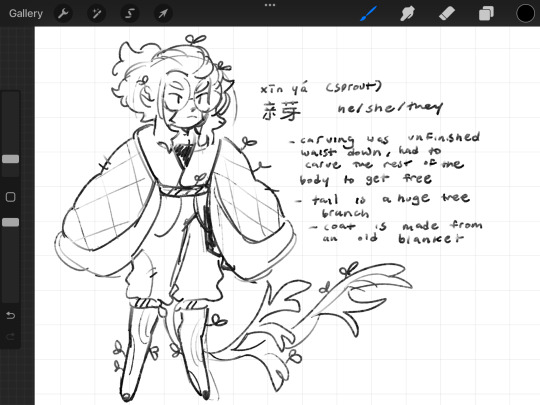

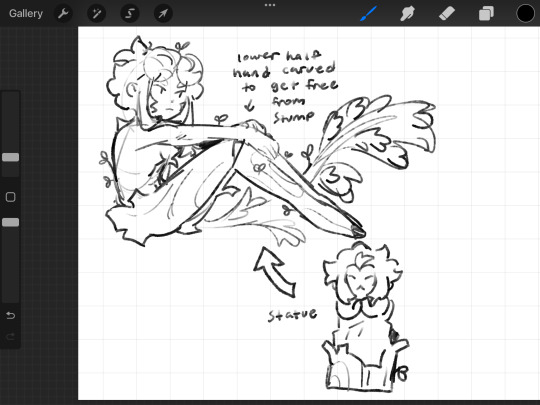

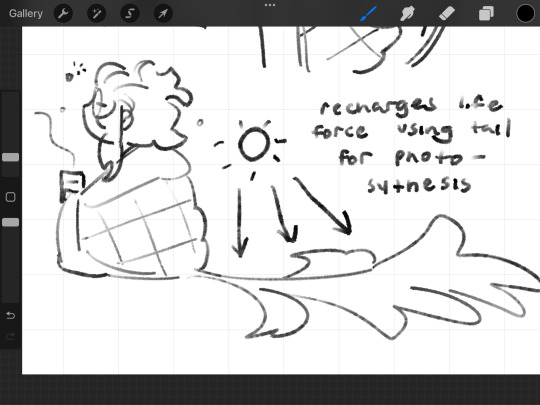
I made a lmk oc
#they’re supposed to be some sort of experiment to see if people could recreate Sun Wukongs stone egg. the goal was to make a more controlled#and tame version using carved wood and cultivation. but eventually they got worried about it becoming too powerful and scrapped it#eventually they come to life and live in the abandoned temple they were built in#their bottom half is made of wood because when they came to life their creator/s left them unfinished when they scrapped the project#they had to carve the rest of their body out of hunger and frustration because they couldn’t eat or move much by crawling on their top half#this is also why they spite their creators and hate irresponsible creation. because of abandonment issues and feeling like they have no#purpose or direction in life#their power is also very limited to due being man made since they were originally a wood carving#meo gave me the idea but one reason would be because they’re half finished. the sculpture was still half stump so it was completely untouche#that half can channel power in its raw form but the other half cannot once it’s been carved by man#so technically they could have the same level or potential for power as the stone but that was dampened#the other thing is how they were created to be a duplicate or recreation of a stone monkey and a celestial looked at that and was like#‘we’re not doing that again’ LMAO#i think the case of them carving their own legs doesn’t take away their power though. that balance was made#before they came to life so carving the legs or not can’t affect it anymore. like making a cake and slicing it#their energy levels are also naturally low because of that so their movements are sluggish and they aren’t very active overall#constantly lying in the sun to charge their batteries and get some stuff done. just like me fr#I actually don’t know what I’m gonna do with this character besides Put Them In Situations with other ppls ocs.. so if you have#a lmk oc you have been warned /lh /j#I wanna make some backstory art for them though.. maybe even the animatic treatment if I can get through dear wormwood which is 25#SECONDS OUT OF 3 MIN BTW#doodles#Lego Monkie kid#lmk#Monkie kid#lmk oc#monkie kid oc#myart#my art#xin ya
200 notes
·
View notes
Text
I am going to say something that has really been bothering me that not everyone may agree with, which is totally okay, everyone is entirely valid to disagree with me: There is a fast fashion problem in fandom, specifically fanfiction.
Disclaimer: This conversation is not about broadly writing the same tropes, genres, and ideas. I am not talking about people writing fics with similar themes or the same name. I am specifically talking about people writing fics that are very obviously heavily influenced by other fics. This is not me talking about: I wrote __ character as enemies to lovers vampires and so did this person so they stole. Please do not trivialize this conversation with instances that are very obviously not what I'm talking about.
As someone who exists in the fanfiction space, I want to express what I have seen specifically in this space in my own experience, my mutuals experiences, and random experiences I have seen on my dash.
Recently, it seems like there is a reoccurring theme of writers (often new writers) taking "inspiration" from fanfics that they love and value and essentially creating their own version of that story to the point it is bordering on plagiarism. I say bordering on plagiarism because while people may not be copying line for line or entire scenes in order, you can tell that it is a re-arranged duplicate of another story.
I am not talking about writing similar tropes and dynamics. No one owns a trope or a dynamic. I am specifically talking about people taking the plots, scenes, concept and core of fanfics and recreating it and changing some plot elements or placing it in a different alternate universe and calling it their own, when at the heart of that fanfic, it is taken from someone else's creation.
This to me, reads like people who read a work, fall in love with it, but think 'this is easy to do, I can do this myself' and they end up making a replica of a fic that you can tell is a replica of another fic, despite adding some changes. Nine times out of ten, these inspired fics lack the obvious thought and heart the original writer put into it.
Which, begs the question: How is this different than fanfic writers taking inspiration from media (i.e. published books, movies, music, shows)? Because fanfiction is meant to replicate a specific something from published media. It is not meant to duplicate an already established fanfiction contribution.
I know that the nuance between that line is very ambiguous and it brings up the discourse on 'should there be fanfiction of fanfiction' - to which my response is it is, generally, pretty obvious what the difference between being inspired by a fic and copying a fic are.
In the last few months, I have lost count of how many times I or mutuals have a) discovered someone has been writing a story based off of their fic 2) have been asked to use an already written work to make their own or 3) already have started writing works modeled after an already written work and in hindsight asked the author if they could keep doing so (this third instance almost always happens after someone accuses them of stealing another work).
This feels like the fast fashion industry. Someone finds a story that is popular (whatever that means to the individual), takes all of the elements they think makes the story works, rearranges it, posts it as their own and and says they were 'inspired' (if they credit the original story at all).
This is why so many works that readers are coming across feel like they are the same thing. It is the same A + B + C = D over and over and over again, because people are outright just taking what they think works from other stories and using it.
Again - I am not talking about people who come across a trope, AU, genre or dynamic they like and add something similar to their story. I am talking about the people who are very intentionally and obviously writing the same exact fic with their own 'twist' (whatever that means).
Why is this a problem (beyond the fact that it's essentially roundabout plagiarism)? You're taking the heart, soul, and creativity someone poured into something and posting it on your own and robbing it of the originality, the essence, and the intention behind it. You cannot replicate a writer's feelings and obvious emotions that they have poured into the original work, and it shows. And it is gutting to the original authors who are finding remixes of their work across the fanfiction space.
Please consider whether or not you are inspired by a story or if you are redoing it in your own image. If you find yourself worried enough about your story that you feel like you have to publicly credit someone to avoid scrutiny, perhaps the question needs to be asked of whether you're just redoing what someone else already wrote.
Please do not confuse inspiration and recreation. 9 out of 10 authors will love that they inspired you to write, but would not love to find that you wrote a fic inspired by them that is a rearranged or hollowed-out version of the fic they wrote.
The fanfic space wants and needs more writers, but it does not need people unwilling to create their own art, instead taking bits and pieces from others and calling it a success.
Also adding: This problem also directly contributes to 'smaller' writers or more niche (often queer and bipoc) stories not getting the hype, readership, or recognition they deserve. On more than one occasion I've seen stories that had explicitly queer or bipoc characters taken and turned into heteronormative or white-presenting stories.
Note: This 1000% goes for actual visual art as well, including gifs etc. in fandom but I'm not well-versed there and thus, did not include it.
#i genuinely have very much like been pushed to the edge this week#and i feel like getting this off of my chest#and i don't think i am crazy but maybe i am#this is also a VERY broad rant of what i'm talking about and does not cover all the nuances of this
442 notes
·
View notes
Text
One of the problems with science fiction is that there is no secular term for the soul. It's a religious concept with no scientific basis, but artistically it conveys a very important idea that I think sometimes gets lost in sci-fi. It's a simple term for an important idea that gets rejected out-of-hand because it's a religious idea, but it actually matters a great deal for non-religious reasons.
In essence, soul is an easy shorthand for the breadth of one's inherent, individual being-ness. To avoid the kneejerk associations that sci-fi fans have to the word "soul", I tend to use "continuity of consciousness" to try and explain this idea. But a lot of times people still don't quite seem to grasp it.
In essence, there is a tendency in sci-fi to think of people externally. A person is their demonstrable factors. Their appearance, their personality, their memory, their experience, all things that can be interacted with or recreated through the magic of super-science.
If you clone Joe, then the result is Joe! We brought Joe back to life through cloning. Now Joe is here with us again. And if we clone Joe again, we get two Joes! Isn't that amazing? And they're both Joe!
But.
Like.
We don't think of people internally. Are they both Joe? Is either of them even Joe? Or are they brand new people saddled with Joe's memories and personality and history?
What happened to Joe? We're only thinking about Joe in terms of our perspective as people who are not Joe, but what was Joe's experience? Did he actually die, and then wake up in a new clone body? Is his continuity of consciousness preserved? Did he actually experience coming back to life? Or did Joe die, and now Joe is still just dead. And there's been a new consciousness created to inhabit the clone?
What does this experience look like from Joe's perspective? Not Clone Joe. Original Joe.
Severed from its religious meaning, this is what the soul is an artistic shorthand for. Joe's "soul" is a simple and easy way of conveying the question, what actually happened to the inherent consciousness/personhood/continuous thinking existence of the true Joe? Does the clone share the same "soul" or does it have a new "soul"? Do their consciousnesses continue from one to another or are their consciousnesses separate?
Even calling it "consciousness" doesn't fully convey this idea. Because they can have different answers for that. The clone may feel that their consciousness extends back throughout Joe's death and life, while the original Joe's consciousness nonetheless ended at death. There is no secular term for the inherent quality of a continuity of individually existing, in and of itself.
And because there's no secular term, we just don't think about it.
But I do. I think about this every time I'm presented with a clone or a time-travel duplicate or a parallel universe counterpart, and told by the story to treat them as if they were the same. If this character does not share continuity of the original's consciousness, then they are not the same. Even if all other features are identical.
And I don't know how to express that with words.
708 notes
·
View notes
Text
The themes of NieR Reincarnation
A post about the recurring elements of Drakenier and the use of branching timelines as a storytelling device. I'll be discussing spoilers for basically every DoD/NieR game.
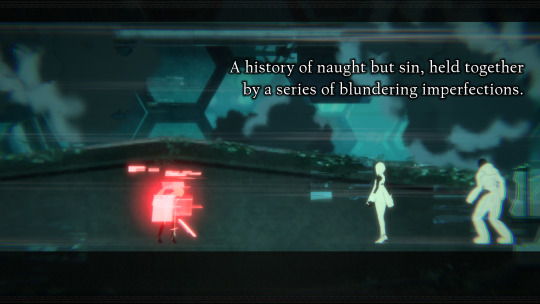
Records
A somewhat understated recurring motif of the Drakengard/NieR series is the idea of stories or memories of humanity being stored in some massive archive.
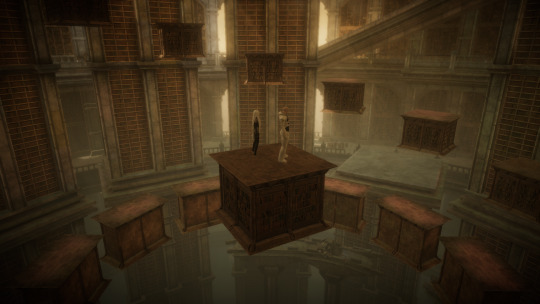
It's an idea that first entered the series in NieR Gestalt/Replicant. Early drafts of the game focused on the idea of a world built out of stories and fairytale characters, and while most of this was cut, some remained in the Forest of Myth area.
Following NieR's obsessive love of hopping between different game genres, the story here is delivered through prose/text adventure segments. There is a sense that this area of the game exists as prose, with the characters slightly aware of narration - narration which absorbs the characters until you find a way to escape. Eventually you find out - it's rather cryptic in the actual game, but spelled out explicitly in Grimoire NieR - that it's a huge computer system storing records of the deceased humanity.
In your second visit to the area, the story focuses more on distant history, that all these stories are fragments of memory of the lost pre-apocalpytic world. You encounter a Gestalt (human soul extracted from body) that is eating the memories stored in the tree, and kill it, and for Nier and co., this is enough - but for the player, you really don't know half of what is going on.
In the story The Lost World, which was adapted for the additional Ending E added in the Replicant remake, Kainé returns to the Forest of Myth and finds the computer system expanding. She fights clones of herself before eventually speaking to a mysterious administrator and descending into a virtual world that seems like a corrupted version of her memories. But she's able to connect to her memories of NieR, Emil and Grimoire Weiss, and through that connection cause a kind of timeline collapse effect that allows her to resurrect Nier. Terms from DoD3 such as 'singularity' come back again.
youtube
In NieR Automata, the idea of the legacy of humanity becomes increasingly central. While the androids believe they are reclaiming Earth for humanity, the Machine Lifeforms' motivation is in large part driven by their efforts to pore over the records of humanity and learn how to evolve their condition, even by blind imitation. Many of the different Machine Lifeforms you encounter are shaped by their interpretations of human society. The motif of human buildings recreated in white blocks recurs at certain points.
In the final sequence of the game, you climb a tower, and inside it visit simulacra of locations from the Replicant/Gestalt. You learn that the machines have infiltrated the androids' network and downloaded basically all the information the androids have, including all their records of humanity. When the machines' 'Ark' is launched into space, it carries their memories and consciousness in data form.
The YoRHa: Dark Apocalypse raid series in FFXIV continues this idea of obsessive, blind reconstruction. The machines you fight here are now all the more explicitly connected to the apocalyptic shit in DoD; they have also been frantically creating duplicates of YoRHa android 2P, the Bunker and so on in corrupted form. Although the story here has mostly other interests, it's another recurrence of the idea of trying to recreate things that were lost.
Along with this idea of the archive comes the idea of preservation of that archive. Whether by accident or deliberate attack, the survival of the archive is not guaranteed.
This is all absolutely central to what Reincarnation is about.
Branches
The Drakenier series has played around with branching narratives pretty much from the start. It's somewhat infamous for it in fact - did you know that NieR is actually a spinoff of ending E of Drakengard, the one where you appear over Tokyo and have to do a rhythm game? Yeah, so...
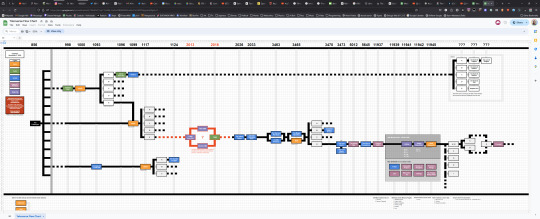
Most games are fairly cagey (ha ha) about the mechanics of these branches. Indeed, although we speak of branches, the structure of these games is not really a branching one like a visual novel. The branches and 'endings' are usually unlocked sequentially.
Drakengard/Drag-on Dragoon (DoD1) is probably the closest you get to a traditional branching structure. You can unlock routes in certain missions by fulfilling certain conditions. The exact logic of these branches is not really explained - you can go back to a point before you recruit a party member and get a different branch where they're present for example. That said, it's not like a visual novel where you can be 'on' one branch or another - you can always jump to any level from any timeline.
This oddness of the branches is also lampshaded a little more in DoD3, the game that is most explicit about the nature of the branching timeline. DoD3 is, from the player perspective, a linear game. After you complete the first 'ending', you unlock new levels that appear at earlier points in the timeline, and diverging branches appear. In the later branches, the logic of the world is starting to break down. Party members who you'd recruit later in the story are in your party much earlier, in some cases suffering from amnesia, the implication being that it's an effect of the Flower's corruption.
The game is intermittently narrated by a character called Accord, an android 'Recorder' whose job is to document all the different versions of the story for an unknown party. Accord isn't supposed to intervene in the story, though she occasionally talks to protagonist Zero, and in the final D route, she decides to break the rules and save Zero. Otherwise, she's responsible for 'sealing' branches where it seems the world cannot be saved.
This is Accord:

The final cutscene of DoD3, available only after you beat the ludicrously difficult rhythm game that is the 'final song', shows a bunch of other Accords appearing and talking about what a mess this all is.
Accord's other role in the game is to sell weapons. Another series tradition running back to DoD1 is the 'Weapon Stories'. In each game, you can collect weapons, which can be upgraded through a series of four stages. Each stage unlocks another part of a story. These stories tend to be quite brief - each entry is at most a short paragraph. They also, particularly in the DoD games, tend to be comically grimdark.
DoD 3 came out after NieR Replicant/Gestalt, but in every game since then, there have been cryptic mentions of Accord. In Automata she's mentioned in a note as a weapons seller; in the updated version of Replicant she is mentioned as visiting Nier's village while the party is away on her adventures, and you see a documention that mentions the 'Accord Corporation' supplying magic weapons.
OK, so, put a pin in that, we'll come back to her later.
The side material commits further to the branching idea. The original Drakengard is established to follow from the DoD3 Story Side novel, while Branch A gives rise to the Shi ni Itaru Aka manga and the DoD 1.3 novel. The YoRHa stage plays spawned alternative versions, namely YoRHa version 1.3a and Shōjo YoRha version 1.1a, with the gender of the casts flipped. YoRHa 1.3a also has Accord in it. The anime NieR Automata ver. 1.1a also presents an increasingly diverging version of the events of the game - notably, Adam turns into a multi-armed monster.
DoD2, something of the black sheep of the franchise, was originally written to follow DoD1 ending A; later it was retconned to belong to its own branch. Just 'cause.
With me so far? ...no? Yeah, that's fair. You can read about all the details I've gathered so far here, but in short, there are lots of timeline branches, and multiple versions of several stories with small or large divergences.
Reincarnation
NieR Re[in]carnation is a gacha game that's been running for the last three years, and is going to be shut down at the end of April. At the time it came out, it was acknowledge for having unusually nice graphics for a mobile game, but rather desultory, grindy, repetitive gameplay. Which remained true throughout the game's life, so I can't exactly recommend playing Reincarnation, especially at this point.
But! I would definitely say it's worth your time to dig up the story on Youtube/Accord's Library if you're into NieR stuff. I won't be going into all the ins and outs of the story and how it all fits together in this post, but I am gonna talk about how it's structured.
NieR Reincarnation places you in a vast stone city called the Cage, calling to mind the environments in Ico. At the outset, you play as a young girl travelling with a weird ghost-like creature called Mama, tasked with restoring the memories stored in objects called 'dark scarecrows' which are being subverted and corrupted by black birds which form into various monsters.
Within each chapter of NieR Reincarnation, you get a short story in four parts, presented in a kind of cutout style, which are the four segments of a weapon story. You collect the weapon and the character.
The Cage is shaped by the content of the weapon stories somehow bleeding into the simulated setting. A character's memories can be used to restore the stories to their proper course. It is possible to interfere in small ways with the worlds of the stories.
The corruption of the stories tends to involve subverting characterisation to make them crueller, more prone to random violence etc. - or points when a character could be threatened in a narratively unsatisfying way. For example, a peace-loving runaway prince could be turned into a warlike king.
Over the course of the first arc, you discover that the girl you are playing is actually a monster who has taken the form of a human girl and, regretting it, wants to give her her embodiment back. The second half of the arc has you playing the girl trying to reunite with her monster friend; at the end, you get her own backstory as a victim of brutal prejudice. After all is said and done, both characters transform into weapons, which Mama picks up and hides away.
The second arc, The Sun and the Moon, deals with a brother and sister from present-day Tokyo. Both of them have been transported into the Cage by more of the weird ghost thingies, to participate in a strange ritual that is allegedly going to restore the Cage. The rules are highly mystical - a significant sacrifice is needed.
In the most recent arc, The People and The World, the characters all emerge from their stories as the Cage becomes increasingly corrupted. We finally get the long awaited point where these characters can interact with each other, and advance the stories from a series of tragic vignettes to something more. At the same time, we get a lot more allusions to other games in the series - from the Lunar Tear room where Emil memorialised Kainé and later 9S memorialises 2B, to a brief appearance Devola and Popola.

There's even a nod to Yoko Taro's other terminated gacha game, SINoALICE, which is going to be made into a movie oddly enough. There's a wry nod to the game being shut down.
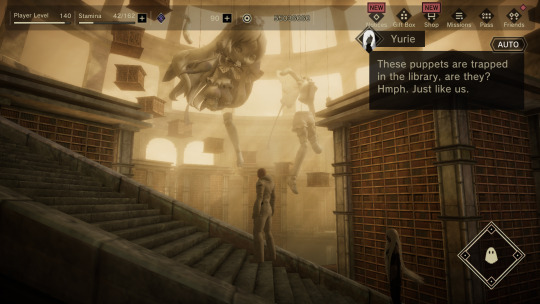
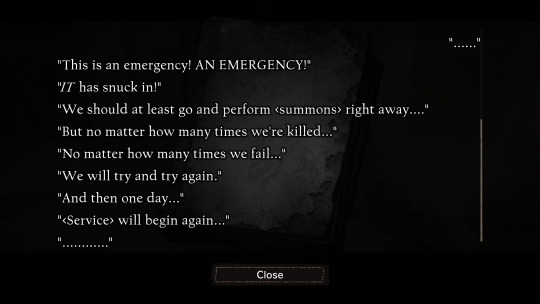
And in the most recent chapters we find out that the Cage is actually a server on the moon containing records of humanity - 10H from A Much Too Silent Sea is one of the main characters. 'Mama' is actually the Pod tasked with overseeing the archive, and wiping 10H's memories whenever she learns too much - though it seems at some point 10H learned the truth and affirmed that she'd protect the archive anyway and they stopped wiping her memory.
Over the course of the chapter, 10H helps the gang make their escape from the moon through the androids network, to Earth. But when they get to Earth, they find themselves in a strange white city more resembling the Cage.
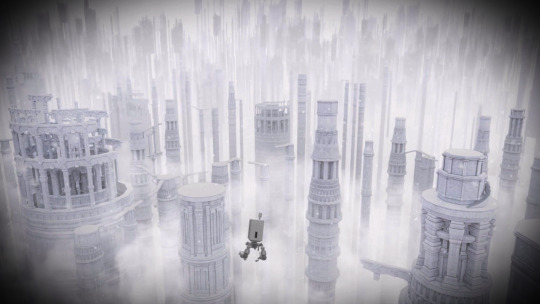
We'll finally get some answers, maybe, later this month. Anyway...
So, these records come from multiple diverging timelines, and they take the form of weapon stories. You have a unity of the ideas of character - weapon - memory - world. A record is simultaneously a tragic series of events, a person who can manifest inside the Cage itself, a simulated world which other people can visit, and a weapon.
In addition to the main storyline chapters and 'character stories', each character is associated with two additional 'EX' storylines, termed Dark Memories and Recollections of Dusk. Each one is a much more substantial narrative than most in the game.
Some of these EX stories clearly take place in different timelines to the first ones we encounter. Akeha's story, for example, takes place after her death in the original version. For the brother and sister from the Sun and the Moon arc, originally from present-day Tokyo, their Dark Memories take place in the backstory to NieR Gestalt/Replicant - the period where humanity is dying out to White Chlorination Syndrome and fighting monsters called the Legion. In this one, before the siblings could be torn apart by family drama and resentment, the apocalypse happens. Both of them end up coming into their own as heroic fighters. In the finale arc, the characters learn a bit about these alter egos, and it's made very explicit that this is a different timeline.
The monster Levania's Dark Memory is especially weird. It's the story of a salaryman who plays a monster called Levania in an MMORPG. His MMO character inspires him to live more bravely in the real world, and his life seems to be improving, but he is murdered by a jealous coworker. He wishes for reincarnation as he dies - classic isekai stuff. But the connection to the Levania you encounter in the main story is far from clear. Are all versions of Levania derived essentially from this man's tulpa?
The nature of the 'enemies' attacking the Cage is still not yet clear. They take the form of black birds. The birds are given a small amount of dialogue and characterisation, and they seem to not be malicious, just confused. The girl from the first arc in particular tends to interact with them sympathetically. However, they seem to be connected with the mysterious 'God' who was trying to destroy the world in DoD1, and the Angels and Flower of DoD3.
The birds are able to gathe together to manifest much larger monsters, the largest being giant elk and fish called Cursed Gods. During the finale arc, one of these becomes something that resembles the Mother Angel from DoD1 - and yes, there is a rhythm game - though mercifully a pretty easy one.
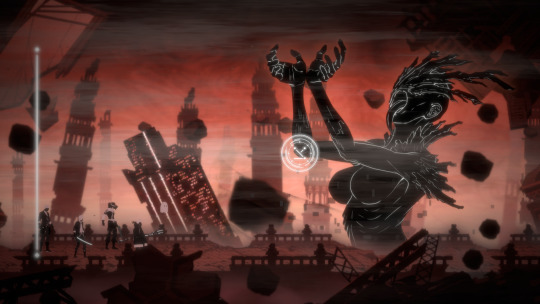
In the same arc, the character Yurie, an AI city overlord with grandiose ambitions and a loathing of imperfection attempts to download the entire history of humanity from the Cage and become a more perfect being. She succeeds, only to find the answers disappointing...
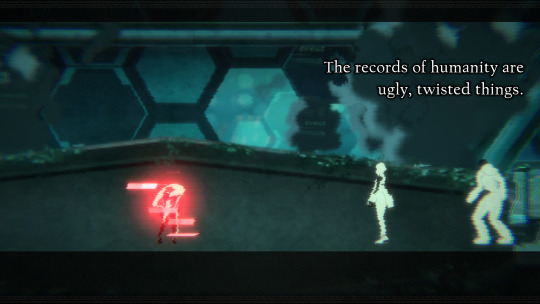

This is perhaps the closest thing we ever get to an explicit statement of what all these stories and histories add up to, but despite all this, the throughline is very strongly that these stories are essential to preserve. NieR characters exist in small groups, and it is their intense connections to these others, their treasured memories of travelling together, that motivate them to fight to preserve that thing, even if the results are destructive.
Similar themes emerge for example in Noelle's Recollection of Dusk story, which sees her travelling to preserve a place valued by her sister in crystal. And they also connect to the theme of sacrifice - the recurring ending device where the player must delete their save data in order to help someone (something echoed in Hina and Yuzuki at the altar of the sun and moon, or Levania and Fio). It's perhaps fair to say that nothing is more valued in the world of Nier than memories of a treasured person.
What about Accord? She has in fact made a brief cameo in Reincarnation already...
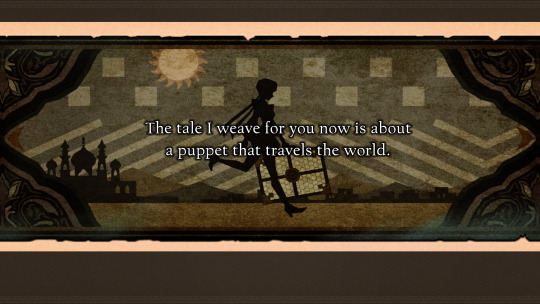
It seems incredibly likely that Accord originates from the Cage, and the accumulation of weapon stories is accomplished by androids like her. Definitely in the fandom there's a lot of excitement for the idea that Accord - something of a fan favourite - will show up at Reincarnation's ending.
So mystery solved, the Cage exists in the world of NieR Automata on the moon server? Not so fast - there are various discrepancies which seem to suggest that the world of the Cage exists in a separate branch than the one we see in Automata. For example, the androids are aware that the humans are dead and what remains on the moon is a huge archive of their memories; the humans seem to have survived much longer; 2B and 9S seem to have died in different circumstances. There are other oddities which fans have compiled.
And yet, despite being a divergent timeline with a much older point of divergence, some things seem to be fixed. There is still a YoRHa, still a 10H deceived about being on the moon, still a 2B and 9S.
One popular fan theory is that Reincarnation belongs to the NieR Automata anime (ver1.1a), since Adam turns into a monster there similar to the ones in Reincarnation. The black birds are reasoned to be the Machine Lifeforms, since we know they come from Earth. I'm not 100% sure of this, but maybe?
Anyway, that's basically the gist of it.
A story told through permutations
In many fictional series with a shared universe, there is an effort to maintain a consistent shared universe, so all the different events can fit into a timeline with understandable cause and effect and characters living out their lives. Even when this proves impossibly unwieldy, as in comic books or Star Wars, the attempt is made.
NieR does not really take this approach. The creators leave many details of the world, such as place names, incredibly vague - the focus is always on telling an emotional story with characters. There is, as we've seen, an almost gleeful willingness to declare another new timeline.
There is also a certain aspect of repetition, or more kindly reiteration - the same core character dynamic revisited and retold in various forms. (2B9S gets the worst of it). A character is something like a principle or ideal, and each story shines another light on that 'core'. In the earlier storylines of Reincarnation, it became quite frustrating because it seemed like e.g. the character event stories were just rehashing the same idea rather than advance the story.
However, the more accustomed I get to this style of storyline, the more I think this kinda works. It is of course quite similar to the ideas proposed towards the end of Homestuck, or to time loop stories - the idea of varying the contingent circumstances to try to better illustrate the core characterisations and dynamics.
Yoko Taro has talked about how he constructs stories from a very simple idea, typically a moment of high emotional impact at the climax, and then works backwards to figure out what sort of story could lead into that. In Reincarnation, each character gets fairly limited time to establish themselves, so they tend to be defined in terms of a pretty narrow high concept.
For example, Akeha is an assassin in a vague historical Japanese setting; her introductory story sees her decide for the first time to disobey her lord after she finds another person who has been treated as instrumentally as her. Most Akeha stories focus on her assassinations, her relationship to her retainer, and what she sacrifices to perform the duty. Only her Dark Memory lets us see an Akeha who has escaped that life - it's a simple story about preparing food, but that's given meaning by all the other Akeha stories.
Hina and Yuzuki are defined by the same traits in their flashy scifi Dark Memory stories as in the more mundane ones - Yuzuki the quiet outcast, Hina the self-sacrificing star. Fio is defined by kindness in the context of abjection, seeing the good in monsters. Levania stories are about the desire for escape and transformation. Argo is always a shitty dad who only feels alive while climbing mountains.
The staticness of these characters seems on some level to be the point - in that we are told in Hina and Yuzuki's story that the mechanism of the Cage is to sort characters into 'Light' and 'Dark' natures, and push them to inevitable conflict, even if they try to break free. In the final arc, the characters seem to finally approach some resolution as they leave their contexts behind. Given the themes of Automata in rejecting an inevitable tragic fate, similar movement may be at work. There's an ambiguity - the need to hold on to even tragic histories, vs the wish to not be confined to them. (Perhaps it's significant that it's called the Cage...)
With so many balls in the air and so many mysteries still unanswered, it's hard to figure out how Reincarnation can deliver a satisfying resolution in just one remaining chapter, but the final arc has been really cooking so who knows! But I'm also coming to appreciate it as a kind of broader lens to notice all these recurring elements and tie them together.
Stories about alternate timelines and branching narratives are very common nowadays, particularly as a tool for revisiting a nostalgic franchise. Something something effect of the fan wiki era. So I can't exactly say NieR is doing something completely unique, but I do think there is something to its fragmented, collage-like approach to putting together story elements. There's something quite honest about it - an ability to say 'these details aren't important'.
Yoko Taro always talks about himself as an entertainer rather than an artist. And probably it is true that a lot of this eemerged from an iterative design process rather than being the plan from the beginning (the first draft of NieR envisioned it as something closer to what SINoALICE ended up being, about a world of fairytale characters; NieR Automata began life as backstory for an idol project). There's definitely a strong sense that it's being improvised. And yet despite that, it does feel like it is cohering into some sort of picture, that there is an artistic throughline to all this.
Or perhaps that's just the effect of getting way too invested in something. I won't deny that NieR brings out the fan in me.
Anyway Accord had better show up next month. Guys. You've been teasing us for so long...
#nier#nier replicant#nier automata#nier reincarnation#drakengard#drakengard 3#computer games#Youtube
121 notes
·
View notes
Note
Not Miraculous Ladybug but since I heard you're a fan of Code Lyoko, I wanted to ask a few questions if that's cool. Who's your fav character and why? What's your favorite and least favorite thing about each main character? Fav side character? Favorite episode? Favorite XANA attack? Are we all in agreement that Clone William is best boi? Anything else you want to say about it that no one's asked before? Sorry this if this is a lot, lol.
Favorite Character: Aelita. She easily went through the most development over the course of the show, going from a walking plot device to a capable fighter in her own right.
Favorite Things About the Characters:
Ulrich: He easily has the coolest powers in Lyoko. Twin swords, super speed, duplication, and an awesome bike.
Odd: Similarly, I like how Odd's powers are handled. It's clear that compared to the others, his are the least practical (cat features, a limited supply of "laser arrows", and a shield), but he manages to hold his own through his quick thinking.
Yumi: I like the way she has to struggle the most balancing her personal life with her Lyoko duties. Unlike the others, she lives with her family, so she has to deal with family drama, and that's not getting into what happens once William gets involved.
Aelita: Again, it's the way she goes from a standard damsel in distress to becoming the de facto leader of the team when Jeremie isn't around.
Jeremie: It's really interesting to see Jeramie act as the leader of the team when he isn't much of a fighter, almost like a young Professor X. The other four may fight XANA directly, but Jeramie gets a lot more done. When XANA wiped out Lyoko, Jeramie managed to recreate the entire world, give the other four upgrades to their powers, and create a submarine for the team to use.
Least Favorite Things About the Characters
Ulrich/Yumi: Putting them together because this one is obvious. The "will they or won't they?" stuff. It just got old, and even after Season 3, which has Yumi try to say she just wants to be friends, the show still rode with this.
Odd: He's funny, but there are still times when he can be pretty annoying.
Aelita: There are admittedly times were it felt like the show kept coming up with ways to endanger her. It made sense in Season 1, but by Season 3, it felt a little excessive that XANA needed her to destroy Lyoko.
Jeremie: I always found it disappointing that we never got to see his Lyoko form.
Favorite Side Character: Jim
Favorite Episode: "Aelita"
Favorite XANA Attack: "Temporary Insanity"
68 notes
·
View notes
Text
It's Fictional Throwdown Friday!
This Week's Fighters...
Lapis Lazuli vs Sollux Captor!
Conditions:
No Restrictions.
Scenario:
At a diplomatic meeting between Era 3 Homeworld and Earth C, a comparison between troll blood castes and gem types escalates into a comparison between which is stronger, Lapis Lazulis or yellow blooded psionics. They elect to settle the debate with a sparing match between Lapis and Sollux.
Analysis: Lapis
For eons, long before the birth of humanity, the galaxy saw one and only one sentient race: the Gems of the Homeworld Empire, the loyal servants of the Great Diamond Authority.
Militaristic and imperialistic, the Gems conquered all that they saw for centuries, exterminating life uncontested for centuries until they found one planet: Earth. On this seemingly insignificant blue rock, they encountered two things they had never had to deal with before: sentient life forms and rebellious gems. Horrified by the revelation that they were destroying sentient life, Pink Diamond elected to stage a rebellion against herself under the persona of Rose Quartz, sparking a war that would cost countless lives.
One of the lives ruined in the wake of this catastrophe was that of one Lapis Lazuli, one of Homeworld's teraformers, who was attacked and "poofed" by the rebels in some unnamed skirmish. Captured by the empire and mistaken for a traitor, she was sealed inside a mirror and interrogated for information she didn't have until Homeworld was forced to retreat from Earth. She was then found by the Crystal Gems and, believed to be non sentient, kept and forgotten for decades. It wasn't until she was given to and released by the young Steven Universe that she would ever be freed from her prison.
She wasn't to happy with being held prisoner for centuries, first by her own Empire, then by the very rebels she was accused of being with in the first. Lapis wanted nothing more then to go back home, but as soon as she got the chance, Lapis was again taken prisoner. She had nowhere to go but Earth and Homeworld would keep trying to destroy that and her. It took... a long time before she could begin to think of the planet that took so much from her as a home.
While the road to recovery was long, Steven's forgiveness and compassion eventually allowed her to move past her trauma and integrate into human society, joining the Crystal Gems and becoming a protector of the Earth.
First and foremost, Lapis is a Gem and thus possesses a physiology entirely unique from that of a human. Firstly, her body isn't organic. It's made of hard light, and can thus be shapeshifted according to her desires, so long as she has enough energy for it. As a result, she does not age, doesn't need sleep, food, or drink, and will live forever. Similarly, if her body is every damaged or destroyed, she can simply recreate a new one. The only known way to kill her in combat is destroying her gemstone. But, it should be noted that gems can still be incapacitated by destroying their bodies, as repairing their physical form takes time and can take anywhere from a few minutes to several weeks depending on how long the gem takes to redesign their body. Furthermore, this process leaves the gem vulnerable to bubbling, a process where the gemstone is bubbled by another Gem, thus sealing away their consciousness.
Thankfully, Lapis has a whole host of abilities to prevent this from happening. Being designed for terraforming, Lapis has access to incredibly powerful hydrokinetic abilities. She can create wings to fly, can create chains to bind her opponents, even dragging them to the bottom the ocean, and can even create exact duplicates of her opponents made of water. She has also shown a limited degree of ice manipulation by freezing her water. Her whole job is to terraform entire planets to suit the conquering Gems's needs, by obliterating them with their own oceans. Her control is so great, that she was able to beat two other Lapis Lazuli's simultaneously and stole the entire planet's ocean overnight.
That much water moving that fast would generate kinetic energy equivalent to 35 petatons of TNT.
Source:
Even without using the entire ocean as a weapon, Lapis is remarkably powerful. She can easily send Jasper flying with one watery punch and can create duplicates equal to Garnet while not paying her any real attention. This means that she's easily a match for even the toughest of Gems even at a minimum level of effort. Garnet by herself was capable of effortlessly punching mountains in half, turning sand into glass while playing volleyball, and cracking an escape pod in half, which landed with a kinetic energy equivalent to 142 kilotons of TNT and was fine.
Source:
However, while Lapis is incredibly powerful... her body itself clearly isn't. She can endure the vacuum of space just fine, yes, but even common Rubies can do that. Given that Lapis was one-shot by Bismuth, it's quiet clear to me that she isn't as tough as her waterbending is.
Luckily, she should be fast enough to dodge any oncoming damage. She was able to fly from the edge of the Milky Way and back in the span of four months, requiring her to fly 93,414x faster than light.
Source:
This took place after the episode that explained that Gems physically cannot travel faster than light due to being made of it. Either light speed is much faster in the Universe-verse or writers cannot do math.
Overall, Lapis is clearly one of the most powerful of the Crystal Gems, bringing literally world shaking power to any match she enters, overwhelming all but the most powerful instantly.
Analysis: Sollux
Doom. The Aspect of dispair. Those bound by Doom are fates chosen sufferers, predestined for a life of pain and misery. And there is no better example of that in all of Paradox Space than Sollux Captor.
Born on the alien hell world of Alternia, Sollux was born as a Gold Blood. The third lowest caste in Troll society. Thanks to his status, he was not only relentlessly persecuted, but he was predestined to serve as a living battery for the Empire's warships, guaranteeing a short life of pain and misery once he left the planet. Even on the planet, his life wasn't much better. Largely because a nearby highblood and local 8itch mind controlled him into killing his own girlfriend.
So yeah, as you can see, if you're bound to the Aspect of Doom, then life is just going to shit over you right from minute one. While all your friends are bound to primordial concepts that grant them cool superpowers, you're bound to a concept that forces you to hear the voices of those who are soon to die. Well, okay, I say that, but it's not all bad for poor Sollux. For one thing, being a SBURB Player does give him a few handy perks, like a video game style hammerspace inventory called a Specibus, or a leveling up system called an Echeladder, which goes up continuously as you do random things, ensuring that you're always getting stronger.
Not like Sollux needs much help with that. He's easily the most powerful psionic on the planet, arguably the strongest in history. As a direct descendant (or clone. Kinda. It's complicated.) of the Psiioniic, Sollux has inherited all his absurd abilities and psionic powers. This includes telekinesis powerful enough to lift buildings and eye lasers big enough to vaporize skyscrapers.
Sollux's telekinesis is so powerful, it can overpower and redirect meteors summoned by the Reckoning, including those the size of Australia. That's a feat that requires at least 3 exatons of tnt. And that's on top of it's utterly ridiculous range, allowing Sollux to grab and throw meteors from the other side of the universe or blow up a laptop that was in a different timeline entirely.
Source:
But, as with all things Doom bound or SBURB related, it came at a price. Since Sollux was a SBURB Player, he was inevitably going to witness the end of his race, as it's the job of him and the rest of his friends to create the next universe while their old one dies. Furthermore, he didn't even get to live in our universe, because someone from the universe he and his friends just created traveled back in time to kill all of his friends. The pressure of having to hide from this god-like entity shattered his already fragile friend group, causing Sollux's rival, Eridan, to go on a killing spree. This resulted in Eridan vaporizing Sollux's eyes and killing his new girlfriend... right before Sollux gets dropped down a flight of stairs for unrelated reasons. And not long after that, Sollux half dies from the exertion of pushing his spaceship across the Outer Ring at faster than light speeds, moving at 1,041,320.39 the speed of light.
Ironically, the narration here describes him as supposedly moving at "near lightspeed" and there was a whole spiel from Jade about faster than light travel supposedly being impossible. Yet another case of "writers cannot do math".
Source:
Man, Sollux is just the Spider-Man of the Homestuck universe. He certainly has about as many dead girlfriends. That isn't even counting the time he got forcibly fused with the person who killed his girlfriend (not Vriska, the other one). Yeah, needless to say, when your life sucks as much as Sollux's does, you become something of a grumpy dick. He's relentlessly cynical and pessimistic asshole, which is certainly not helped by his bipolar mood swings and short temper.
Despite this though, Sollux's luck did eventually begin to turn around. He's far and away the most competent hacker in Paradox Space, capable of hacking into a video game that alters the fabric of reality. Eventually, his first girlfriend came back to life as an immortal time goddess and they hooked up again, a little while after Sollux discovered he is now half-ghost. This means, not only does he not age anymore, but he's only half blind now, with only his living half being bound to his pre-existing injuries. So, not only is Sollux Spider-Man, he's also Danny Phantom.
So, no matter how badly life kicks him, Sollux is always going to rain down hell on whoever and whatever crosses his path.
Throwdown Theme:
youtube
Throwdown Breakdown:
I feel like this match up is fairly decisive.
For as much raw power as both of them wield, Sollux takes the edge in the standard stat trifecta. His 3 exaton feat would translate to 3,000 petatons against Lapis's maximum output of 35 petatons, a whooping 85x strength gap in his favor. Meanwhile, in speed, Lapis can move thousands of times faster than light, while Sollux can move millions of times faster. (93,414c vs 1,041,320c, an 11x difference).
However, there is something of an argument to be made here. Both franchises do try to have a rule that faster than light speed is impossible, so wouldn't the gap be closer if we took that at its word?
Well, no. While Lapis would have scaling that borders in lightspeed even without her own feats, Sollux would explicitly be an exception to the light speed rule. His very own Ancestor, whom he inherits his powers from and is technically a genetic copy of, was described as being so powerful that he broke the lightspeed rule, being capable of crossing thousands of light years in mere hours. So it'd be even worse for Lapis if I didn't ignore the light speed rule. If anything, this gives Lapis something of an edge. While Sollux is decently faster, it's only while pushing himself to the brink that he sizably outpaces her.
Though, in Lapis's defense, she has several abilities that Sollux does not. Water chains to restrain him, water clones to wear him down, ice to freeze him solid. The problem with landing those win conditions is power. Lapis could drown Sollux or chuck him into space, as he needs air to breath while Lapis does not, but she'd struggle to do that when he can very easily blast the water away. Lapis has never made a water clone strong enough to match someone like Sollux, so she likely wouldn't be able to here, and if she did, she'd have to use up all her available water to maintain it, as the strength of her attacks relies on how much water she has access to.
I do believe it is hypothetically possible for Lapis to match Sollux if she had access to more water, as her strongest feat is something she did while highly injured, but that's highly circumstantial. If the entirety of Earth's oceans don't give her enough water to match Sollux head on, how likely is it that they'll fight on a planet that would?
Ultimately, that plays into Lapis's greatest issue here. Her powers are all external. She relies on a planet having a lot of water for her to weaponize, while Sollux's power is all his own. We know for a fact Sollux can survive his own power because he fires it out of his face and doesn't obliterate himself. We know for a fact that Lapis can't because Bismuth dropped her in one punch. When Sollux realizes that Lapis relies entirely on the ocean, he can just... throw the ocean into space. That's it. Fight's over.
Both of these characters lack a sizable amount of combat experience compared to their peers. While they're both capable of fighting people their own size, they do strongly rely on being absurdly more powerful than everything in most circumstances. It just so happens that Sollux is the much stronger one here.
This Throwdown's Winner is...

Sollux Captor!
8 notes
·
View notes
Note
Doctor: if you had the ability to clone anyone at all, whom you haven’t already cloned, who would you choose?
Fabius brushes down a little wearily at the white smock with the high collar he is wearing. A gesture of thorough exhaustion. "Ah, the cloning. Something that has gone from being ordered by a hysterical father, to being a necessity, to being a trademark. Which I can't shake, though there are few things more static. I admit to having enjoyed it for a long time. The primarchs in particular are works of art that were very challenging to recreate. But in the end I was just following a blueprint. Admittedly a blueprint that I first had to create - but once I had deciphered the first one, after that it was just variations on a theme. Sobering, isn't it? The progenitors who plunged the galaxy into an eternal war - nothing but a few altered amino acids.
And some mysteries remain unsolved, like the constant reappearance of the flaw in me. That I bring decay right along with every new body, no matter how hard I work on my own blueprint, is annoying.
In the meantime, however, I have moved on from cloning as a pure end in itself. Of course, I could try to see if Trazyn wouldn't pay well for some clones of more important personalities - and I'm sure he has things I would want in return. But with this bizarre creature, one too quickly runs the risk of ending up in the collection oneself.
Out of a very academic interest, I could go and see how a few of the xenos species further away from us could be cloned. And possibly take advantage of them for my real projects. But other than that, I can't think of anything I'm desperate to duplicate or bring back from oblivion. The galaxy is bad enough with its current population." He grimaces at this galling conclusion.
But then he adds, "Purely for amusement, of course, another Horus would always be a possibility. But exposing yourself to Abaddon's famous lack of humour just for a joke? I don't know."
4 notes
·
View notes
Note
idk if it was /essek's/ dunamis potion. i assume there was more than one in existence between then and now
(I'm presuming this is about this post, regarding the potion that got tossed into Ashton's patch by Milo.)
Oh, I assume so as well. I absolutely do not think that that particular potion was the one that Yeza made—it's been six years, and it's likely that whatever Essek did with it, it's been used for something or other. He's a resourceful boi.
However, considering at the time that was the only potion of its kind in existence, there are a few options here:
Between Essek's knowledge of dunamis and abundant free time after leaving the Dynasty, and Yeza's alchemical expertise (and the trademark Brenatto mad scientist vibe), it's not a difficult leap to make that they may have figured out how to prove more without a beacon, or using the second time crystal perhaps.
Yeza might sell them (for a hefty price, I imagine—that kind of rarity would pay for a college tuition in real life, let alone in Exandria), or perhaps Essek does some amount of rare items trade, which would track with his unknown business that takes him away from Wildemount. We can also consider theft, as an alchemist's shop in Nicodranas is not the most secure location.
Though Vess had been leading that experimentation, Ludinus was involved and highly interested, given his presence in Felderwin, and I would be surprised if the Assembly hadn't retained copies of the process of creating the first potion, even if those notes were incomplete, which could've led them to duplicating the process by now with the beacon found in Pride's Call.
If so, it seems unlikely they would get rid of them, given the point was to gain an edge against the Dynasty's dunamantic expertise (though I'm certain Ludinus has other motivations). However, as the Assembly's facilities are canonically not impregnable, it's not out of the question for things to have been stolen and smuggled if someone got wind of them. The Assembly has more conflicting interests than it has members.
The Dynasty put time and resources into research on more purely arcane implements of dunamis. Maybe I, tumblr user essektheylyss, am biased on this one, but this seems highly unlikely to me, given their views on this kind of research up until now. (Also, the Dynasty and the Bright Queen in particular have got other evangelical priorities at the moment—I am once again asking everyone to read Tales of Exandria: Bright Queen.)
Now, granted, there are other beacons in Exandria, but we know of a singular instance of dunamis being distilled into a potion and Matt does enjoy his "consequences for your actions."
Of these, I think the easiest connection to make is to Essek and Yeza, who could both easily do nothing but malewife it up in post-canon, and also have the least bureaucracy to navigate, best combined knowledge and resources to recreate this, and virtually no oversight aside from their significant others who, let's face it, remain as equally questionable about their mad scientist methods as their partners by the end of the campaign. (Necromantic crystal, anyone?)
We have no idea how this got to Jiana, of course, and she does not give off the vibe of someone I think either of them would deal with—it's possible that they haven't been dealing with anyone on this matter at all, and that the item itself or the method for making it could've been stolen, but they are still the easiest to steal from.
This isn't to say that we'll ever find out where this particular potion originated, though; it's impossible at this point to say how many hands an item like this passed through, especially if those people didn't fully know what it was or how dangerous it was to use.
Tl;dr: I don't think the potion Milo put into Ashton's head is the exact potion that the Nein found in Felderwin that was last seen being handed to Essek. But as far as how it came into being, Yeza and Essek are the most likely suspects based on what we currently know.
#critical role#cr meta#long post#ashton greymoore#essek thelyss#yeza brenatto#listen I simply think malewife mad scientist is the best character type and as such I want to belieeeeeve#fwiw I fully believe this is the kind of thing that we're oNLY gonna find out in the wrap up in three years lmfao#like never say never but ashton seems more concerned about what it did to them than where it came from
49 notes
·
View notes
Text
Fundamentals 1: Software Pūmanawa
A bit more compositing

first image of choice to edit into the jumping man Photoshop creation

i duplicated the photo, object selected the magpie, then clicked on the mask icon and then added a blank layer between the two. by clicking option/alt + delete/backspace, in the new layer between the bird and background, we created a fill using the foreground swatch colour. i selected then duplicated the background layer and made it an overlay by putting the opacity down to see all the issues needing fixed
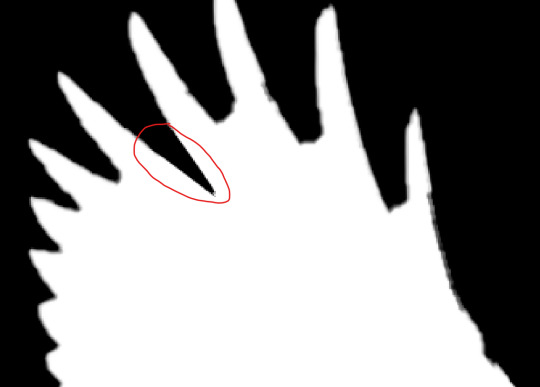
on the mask layer being selected, i created a path around one of the areas that were undesired and needed removal. i turned the path into a selection and then hit delete.

going over a few more areas and using the same technique as shown above has proven success in creating a more seamless cut.

after removing sections we found some areas that were overdone

i ran the white brush with maximum softness over the edge of the feathers of the layer mask

after some touch ups and tweaks i finished separating the background and the magpie

Magpie added to the jumping man composition

this is the 2nd Photoshop image i will edit out of the background.

once again i duplicated the photo, object selected the skink, then clicked on the mask icon and then added a blank layer between the two. by clicking option/alt + delete/backspace, in the new layer between the bird and background, i created a fill using the foreground swatch colour.
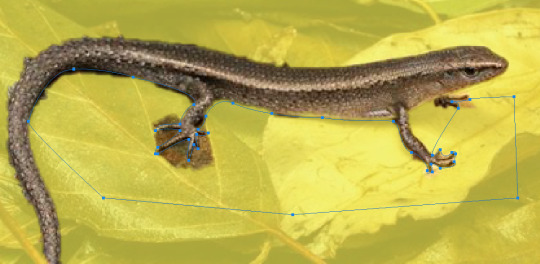

i then created a path around the areas undesired i then made the path into a selection and then deleted the section

i then took the soft white brush around the areas i went a little over

i then added the skink into the background.
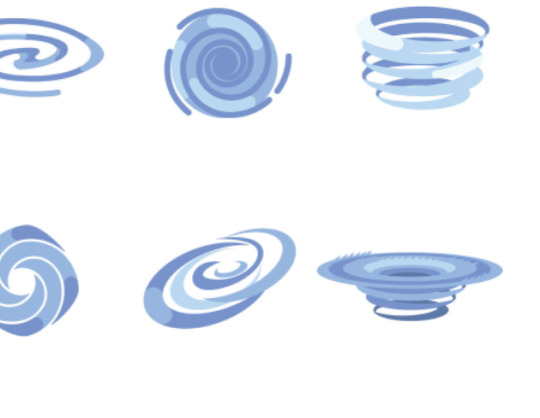
moving on to 2 vectors (one that interacts with the jumping man) i decided on using a whirlpool (the road i grew up on's name means Whirlpool in Maori)
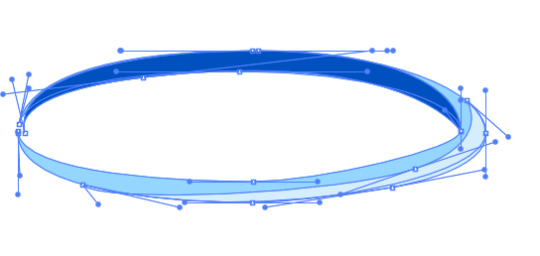
i started with creating one ring of a swirl
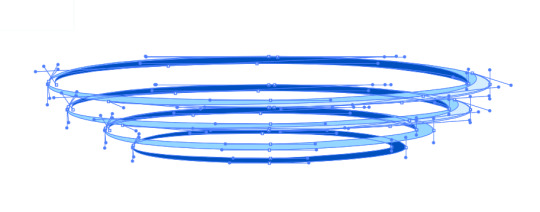
I then duplicated the swirl while removing some parts of the shape ie. the mid colour, highlight and shading

i played around with the shapes and bent some edges to create some uniqueness and natural randomness.
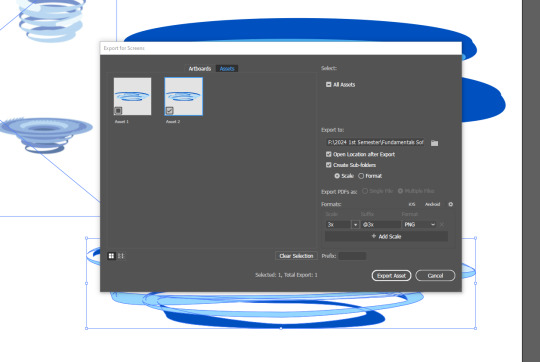
I selected the image and hit export selection, hit 3x scaling and made sure it was in the right folder and then hit export asset.

i then placed it via file > place linked into the jumping man project.

i then duplicated the asset and then moved the duplication below the stylised S.
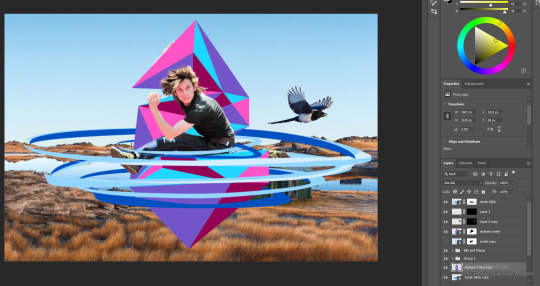
after adding a layer mask to the top duplication of the whirlpool and creating path selections around areas overlapping and parts of the swirls to be put behind, i was able to successfully create an effect similar to the stylised s of the whirlpool going around the jumping man

for my final vector, i will be recreating Carex kaloides, commonly named sedge which has been observed in the area of what the background painting was of(The Poolburn Dam) to be declining.
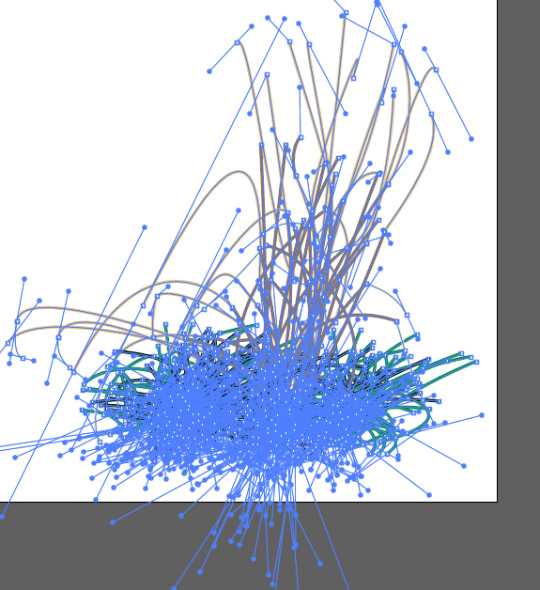

after rigorous play around with stroke shapes, placements and sections of colours this is the end result. i started off with the left down bending straws but realised how drooping i had made it thus far so i gradually had the straw stand up mostly straight as i went on.
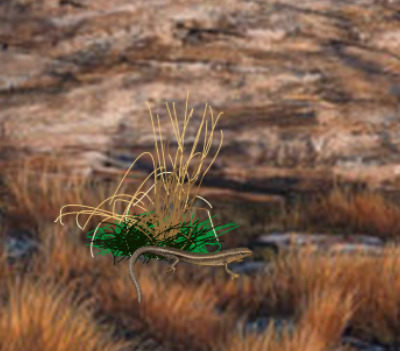
i decided to put the sedge next to the skink cause they looked very lonely :(.

i went over the area with a soft erasor to blend them in better
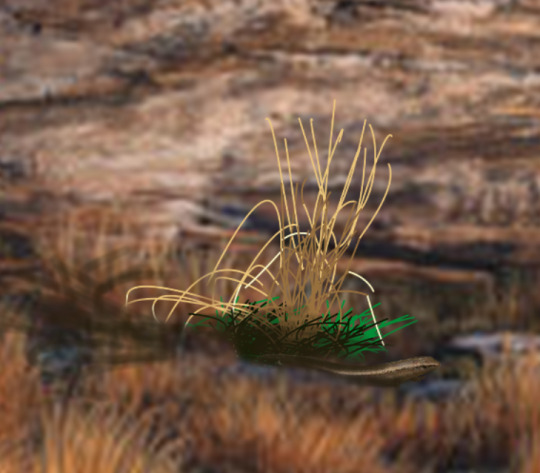
i decided to add some shading to have them work a little better with the scenery

Following all that, we are finished. in reflection this turned out better than I imagined and I'm glad that things fit together well with each other. I'm happy i was able to use images and vectors that well represent the area of the Ida Valley and the Poolburn Dam in an artistic perspective after growing up in that area for many of my young years. the main thing that i would benefit a project similar to this is having more time to brainstorm and go more in depth into the design and creation of the objects. i honestly haven't been able to get around to work on this composition until the day of posting this and the day after. all of these objects and photos are of significance to me. the sound of the Magpies squawking early in the morning among the pine trees opposite to my bedroom window and the poplar trees spread around the farm house. the name of the road i grew up on, Auripo Road, where Auripo is Maori for Swirly Wind or Whirl Pool visualised here with the whirl pool around the jumping man and stylised S. the skinks roaming around up on the hills of my farm that my family has owned for many generations. and the sedge observed all over the place along the Dam and my Family Farm.
0 notes
Text
Maya - Barrel Asset
As a bit of homework I was tasked to recreated a barrel (in broad shape) in Maya. It was a reasonably easy bit of homework, but good fun and I figured I'd break it down a bit here.
Firstly, the source material:
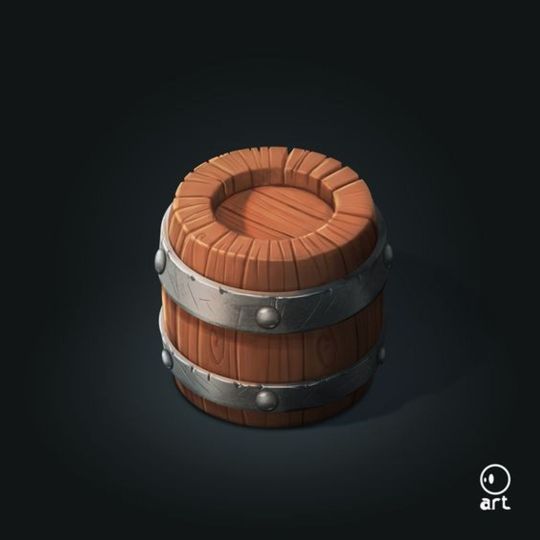
Knowing just enough about 3D modelling I figured out some rough ideas of edge loops from the jump, knowing that otherwise things could get rough.
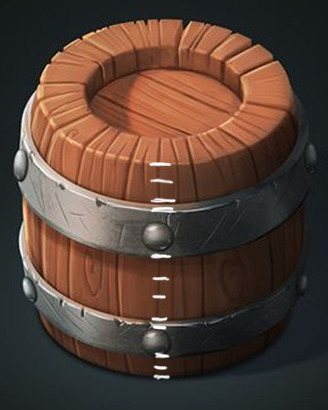
Starting with a polygon primitive, then, was the way to go. Since the barrel has quite a cute, cartoony affect I figured it should be quite stumpy. I decided on 80 cm diameter, 60 cm height, 24 faces around, 10 edge loops vertically and a loop on the cap ready to go.

Next up I moved some edgeloops to make the distinctly spaced metal bands.
I could have made those separate objects, but this felt pretty efficient in terms of polygons, and also a pretty trivial difference.

Selecting the faces of both bands I scaled them out uniformly, then selected each band's faces and scaled in down vertically again, that way the bands would come out exactly the same.
I then selected the top and bottom caps, extruded them towards each other evenly.

Next up I wanted to develop the overall, rounded nature of the barrel, so I selected the very top and bottom vertices as rings turned on soft-selection and increased the area of effect.
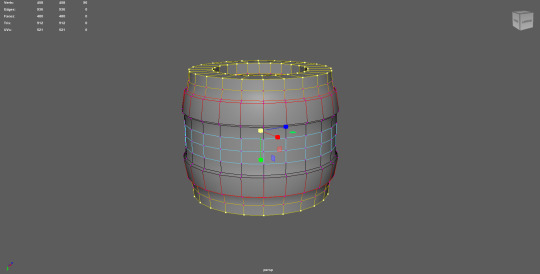
With that selection made, I scaled all the vertices along the X and Z axes, which curved the whole body nicely inward and giving me a nice round form.

Next I selected the middle faces which were out of reach of the previous soft-selection scaling, and just scaled them out to give the barrel a nice, chubby feel, as well as a continuous, consistent profile.

With the body looking right I created new objects to be the bolts that live on the metal bands of the barrel. I used polygon spheres but with a largely turned down face count.
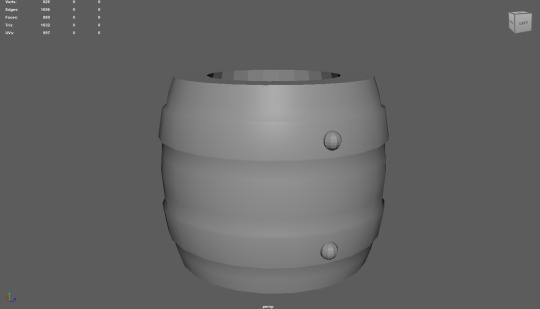
I scaled these spheres down so as to flatten them, then rotated and embedded them in ways that made sense for the source.

Selecting two of the spheres I then duplicated them and put them on the opposite side, largely mirroring their placement (at least well enough at a glance). To complete the form I would need another set of four spheres, so I selected my four, duplicated them, grouped them and rotated them 90 degrees. This fairly trivially allowed me to have a complete set of spheres and in the right positions even on close examination.

Looking over the barrel again I found the shape of the metal bands didn't stand out enough and decided to bevel them to make them stand out more sharply and distinctly.
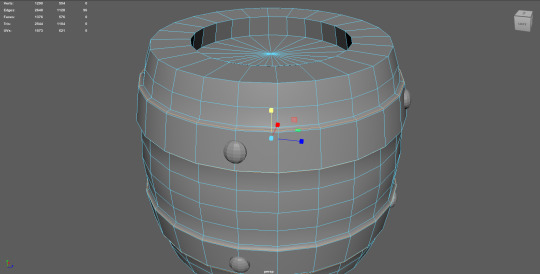
Finally, the form looked pretty much how I was hoping it would.

And here is the final result:

In contrast with the original asset you can see a few differences.
Firstly, the concept has a lot of splits in the wood that mine don't, but that would largely be addressed using normal maps and textures, more than it would modifying the topology.
More importantly, the source image of the barrel has a much cuter shape. I notice now that the metal bands stick out even further than mine do, the spheres are larger and more bulbous, and the barrel itself is bottom-heavy, whereas mine quite symmetrical.

Finally, my asset came out at a total of 1376 faces. This is actually much higher than I should like and I'll need to work on bringing that down, but that's an alright result for the moment.
If I was optimising for a fixed-rotation camera perspective like Diablo 3 I would be able to cut every underside face, as well as almost the entire back half of the barrel... But I would like to know how I might have lowered the poly count from the start without compromising too hard on feel.
Some thoughts that came out of this:
When performing operations in Maya how can I ensure that those operations are precise? (such as when scaling using the gizmo. I can do that to a grid, but what if I want an exact scaling of 69.69?
I need to spend more time observing the source material for quirks and affect. If I had spotted the tricks that made the barrel so cute I would have adapted my technique
0 notes
Text
1959 Agents of S.H.I.E.L.D. series 2
S.H.I.E.L.D. has been running pretty smoothly for some time now. But a pair of terrible twins are about to disrupt things for the team…Fenris! They are older (77) in 1959 (their age is related to where The Gifted is in this timeline) and some of their story will be told in flashback.
They have been setting up Hellfire Club chapters around the world, trying to manipulate world events in the club's favour. They create terrorist incidents and blame them on other factions, plant misinformation etc. They have also been finding or rescuing promising mutants then enticing/forcing them to join.
Nathaniel Essex is referred to as "our employer" but never by name. No one has been able to work out how the bombs were planted in these incidents, but Howard works out that Fenris are the bomb, managing to link these incidents together and build up a profile for the now elderly Von Struckers.
In a slight rework from the original The Gifted timeline, the London incident should be 1915 and it's the Police in pursuit, Rio should be 1930 with SSR investigating and pursuing. They manage to evade capture until this series.
They chase them across the world after the latest incident in Plac Zamkovy, which kills hundreds. They can't figure out what gives them this power (no one knows about mutants, except Otto Strucker). They finally catch up with them and Andrea is killed before they can detonate. Andreas flees to grieve and consider his next move.
They have embedded themselves in Hydra to disguise their true allegiance.
Peggy, Howard, the Howling Commandos, Brian and Jacqueline Falsworth are all present but Adam Brashear is now off world and Sousa 'died' in 1955 as per original AoS s7 continuity. James Braddock (actor tbc) is more prominent here after being a background character previously, also he had "mystically given" powers, but kept them secret from all but a select few, also a great scientist. Very useful for S.H.I.E.L.D. and S.T.R.I.K.E.
As a second arc in this series Howard and Anton Vanko finalise their prototype for the arc reactor. Howard wants to keep developing it in secret, with a view to sharing it when he is sure it can't be copied or duplicated without them both. He has learned his lesson from season 1 of Agent Carter where some of his technology was dangerously flawed or misappropriated. He doesn't want the arc reactor rushed. He doesn't want the technology to fall into the wrong hands. Vanko wants to patent it and start selling the idea straight away.
Vanko: It's too important not to share it right now.
Stark: I see that it could help the world right now, but I am not prepared to compromise on safety or security. If we rush out a design that could be reverse engineered relatively easily it could start another world war.
V: You just don't want to share the technology with Russia, do you? You think Russia is Leviathan? You think I am with Leviathan? I have known you 13 years Howard…
S: Now Anton, it's not like that, I just need to put in some checks and bal-
V: You want to take all the credit! Where is the proof I was involved in the design if there is no patent?
S: Now wait a minute Anton-
V: You want all the profit too?
S (scoffs): This shouldn't be about money.
V: This is easy for you to say. You live in America like a billionaire, I live here like a Russian immigrant.
S: I pay you well enough Anton…Let's just…let's just cool off…talk about this in the morning. We can work this out.
V (tersely): Good night, Mr Stark.
By the next morning, Vanko has gone and so have the blueprints. S.H.I.E.L.D. tracks him down and recover the blueprints and hand him over to the company lawyers who have him charged and deported. Howard is too angry to object to the industrial espionage charges or the deportation. He does, however, offer to pay Vanko his share of any profits their design makes. Vanko refuses, arrogantly thinking he can recreate the designs on his own in Russia. He cannot and ends up drunk and destitute setting up Iron Man 2.
Post credits:-
With the Fenris bomb duo out of the picture, we see Sebastian Shaw at the Las Vegas chapter of the Hellfire Club taking a phone call from his employer saying he "would be delighted to be the new black king". After he hangs up he says "now to find myself a queen".
#mcu#marvel cinematic universe#iac#it's all connected#marvel#peggy carter#howard stark#agents of s.h.i.e.l.d.#the howling commandos#jacqueline falsworth#spitfire#brian falsworth#union jack ii#james braddock#captain britain#fenris#andrea and andreas von strucker#anton vanko#sebastian shaw#hellfire club
0 notes
Text
How to Avoid Duplicate Conversions and Recreating the Conversion Funnel for GA4
As you’re probably all too aware at this point, GA4 is coming. Old versions of Google Analytics will be switched off for pretty much everyone come June 2023.
While GA4 is improving all the time, there are quite a few things that people are used to seeing in old versions of Analytics which, at the very least, take a bit of creativity in the new world.
One example is how conversions are handled. In the old versions of Google Analytics, a conversion could only fire once per session. In GA4 conversions are just another kind of event, so it’s possible for a conversion to fire multiple times in one session.
Problem is, you might be very interested if someone signs up via your contact-us form once. But that person might reload the thank-you page, or sign up for something else via a different form on the site. That doesn’t mean you necessarily want to track two conversions.
Speaking of signing up via different forms, on some websites, users may wind up on the same thank-you page having taken very different routes to get there. If we don’t have that much control, and we’re having to rely on thank-you page views to track conversions, it can be hard for us to separate out different kinds of conversions.
In old versions of GA you could use funnels with a “required” step. You might have one goal with a funnel requiring your event page, another goal with a funnel requiring a different page, and rely on them to give you different conversions. There also isn’t an obvious way to do this in GA4.
In this post, I’m going to take you through how to:
Avoid double counting in GA4.
Automatically ignore suspicious conversions (like people landing direct on the conversion page).
Recreate the kind of funnels we expected in Universal Analytics (in fact we’ll make them better).
I’ll take you through a few bits in GA4 and others using Google Tag Manager. The GA4 approach is more straightforward, but the Tag Manager is more robust and can help you make sure that all of your conversion pixels are showing roughly the same information (because we’re long past the point where GA is the only place we’re recording conversions).
Managing conversions in GA4
This section is about changes we can make purely through the GA4 interface. As long as you’re sending your page views conversion events to GA4 you should be able to use these tactics without any code changes.
However: There are some limitations of doing things through GA4, for example it can mean that your GA data doesn’t line up with conversions recorded via other platforms.
Avoiding double-counting
Julius Fedorovicius (of Analytics Mania fame) has produced a fantastic guide to making sure that conversions are only recorded once per session.
You should have a read but broadly:
You create a custom audience based on a sequence that begins with “session_start”
You fire an event when someone enters that audience
You use that event as your conversion.
No surprise that Julius has come up with a really smart way to handle the problem of double-counting:
If you’ve created Segments in Universal Analytics Audience sequences in GA4 look very like the sequences we used to create for Segments. However, the old Segments were just a way of visualizing data, whereas Audiences in GA4 are a way of grouping data. We can use Audiences to create something new.
That distinction is important because we can do cool things like fire custom events when someone enters an audience (which Julius makes use of in this solution).
Universal Analytics Segment sequence creator
GA4 Audience sequence creator
The limitations of using Google Analytics audiences
This isn’t really a limitation as far as GA goes but it’s a consideration nonetheless. Julius’ solution is great for making sure we’re not double-counting conversions in GA, but GA probably isn’t the only way we’re recording conversions.
The average site probably has a bunch of separate conversion tracking pixels and those could end up double-counting conversions.
For example: Facebook and Google both describe how they avoid double-counting conversions, but their solutions largely rely on exactly matching transaction IDs, and even if they’re handling it okay, there’s a bunch of smaller fish out there that are also offering conversion tracking and can need a bit more hand-holding.
If we want to make sure that we’re only recording one conversion per session, it’s useful to make sure all of our conversion tracking is working in a similar way. Tag Manager is a great solution for that (I describe a solution in the Tag Manager section below).
You can also run into problems if, for example, your confirmation page is somehow indexed or bookmarked by users — people landing directly on it can lead to weird unexpected conversions. We can also use Tag Manager to guard against that a little bit.
Recreating the conversion funnel
Sticking with the GA4 interface for now, we can also adapt the AnalyticsMania approach to create our funnel-based conversions too by adding additional steps to the sequence.
For what it’s worth, conversion funnels are not the ideal way to categorize conversions. If you can use anything more direct (like the id of the form they’ve filled out, a separate thank-you page) then that’s a much more reliable way to categorize conversions. That said, we don’t live in a perfect world, and sometimes there isn’t the option to completely rebuild your conversion process.
In Fedorovicius’ example we just have two steps in our audience sequence:
Session_start
Indirectly followed by
Conversion
Which basically means “someone lands on the site and then at any point during their session, they convert”.
To recreate the goal funnels you might be using in Universal Analytics - we can just add another step to the sequence. For instance:
Session_start
Indirectly followed by
Visiting our event_page
Indirectly followed by
Landing on our thank you page/converting
That should mean we can create one conversion which is: Users who went through our event page and then converted.
And another conversion which is: Users who went through our sponsorship page and then converted.
There are some limitations here though, for example, what if someone:
Landed on the site
Visited our event page
Then visited our sponsorship page
Converted using the form on either.
They would fulfill the criteria for our event conversion and the criteria for our sponsorship conversion. We’d record a conversion for each and we’d end up double-counting after all.
This is also a limitation of the old Universal Analytics funnels: Just because a step in the funnel was required doesn’t mean the user can’t wander off around the site between that step and their final conversion. So, if it’s any consolation, this isn’t any worse than old Universal Analytics funnels (but we can still do better).
The problem with using “directly followed by”
You might say “well that’s easily solved — at the moment the sequence says is indirectly followed by and we can just change that to is directly followed by”.
Surely that would mean that someone is on the sponsorship page and goes directly from the sponsorship page to the thank you page, right?
Unfortunately that’s usually not what “directly followed by” means because there’s all kinds of things that can get recorded in analytics which aren’t page views.
For example if someone lands on the sponsorship page, and then scrolls down and lands on the thank you page, the thank you page view doesn’t directly follow the sponsorship page view. It goes:
Page view: sponsorship
Scroll
Page view: thank you
So “directly followed by” isn’t an easy solution.
How about “within x minutes”?
GA4 has a really cool feature in the sequence builder where we can set a timer in-between steps. Even outside of tracking conversions within a session we can use it to keep track of cool things like people who came to our site, didn’t convert that time, but came back and converted within the next couple days.
Jill Quick has been talking a bunch about how powerful these options are.
We could use this to say something like: person landed on our event page and then landed on our thank you page within 10 minutes.
But as I’m sure you’ve guessed, that ends up being a kind of arbitrary cut off, maybe someone spends some time thinking about how to fill out our form, or maybe someone really quickly goes to one of our other pages and converts there. This could be better than the basic funnel, but we could also end up ignoring completely legitimate conversions.
So what do we do?
Using GA4 sequences for this is kind of fine, as I say above it’s certainly not worse than Universal Analytics, but we could do better with Google Tag Manager.
Managing conversions in Google Tag Manager
These approaches require you to run all your tracking via Tag Manager. Though even aside
from this, if you’re not already using Tag Manager, I’d advise you to look into it!
Since we need to keep track of what’s happened to a user across multiple pages, these solutions are also going to make use of cookies. In case that fills you with dread, don’t worry:
I’m going to walk you through how to create and delete these cookies (it takes a little Javascript but it’s copy-paste and easier than you think!)
These aren’t the kinds of cookies designed to give away people’s information to other services.
To reiterate what I say above: While this approach takes a bit more effort than just doing things through Google Analytics it allows us to do two things:
Make sure all of our various tracking tags are firing in the same way
Have more fine grained control, particularly if we’re trying to categorise different paths to conversion.
Avoiding double-counting
To recap what we want to do here, we want to make sure that if someone visits our site and converts we fire a conversion. However, if they revisit a thank you page, or go through a different conversion, we don’t fire a second conversion that session.
To do that, we’re going to:
Set a cookie when a user converts.
Make sure that the cookie automatically disappears after 30 minutes of inactivity (this is the default timeout for GA4 sessions but if you think that’s too short you can set it to whatever you want).
Every time we go to fire a conversion, check if that cookie is present and, if it is, don’t fire the conversion.
That should mean that if someone comes to our site and converts, we’ll set the cookie, and that will stop us from firing any more conversions (GA4 or otherwise) until the user has taken a little time away from the site.
Setting a cookie in JavaScript
The first thing you need to know is that we can use Tag Manager to run any JavaScript we want. The second thing to know is that we can use JavaScript to set cookies.
So first: Go to Google Tag Manager, create a new Tag and select the Custom HTML type
Give the tag the name “[Tag] setCookieConverted” and in the html content paste:
<script>
// Get time 30 minutes from now (this is because the default GA session time out
// is half an hour and we want our cookie timeout to match)
var minutesToAdd = 30
var currentTime = new Date(); // Get current time
var newDateObj = new Date(currentTime.getTime() + minutesToAdd*60000); // Add our minutes on
// Set the domain your're working on, this is because we want our cookies to be
// accessible in subdomains (like test.example.com) if needed
var yourDomain = "example.com"
// Set a cookie called ‘converted’ with the value being ‘true’ which expires in 30 minutes
document.cookie = "converted=true; path=/; domain="+yourDomain+"; expires="+newDateObj+";"
</script>
It should look like this:
The custom HTML tag will add the content there to the page, and as soon as the page detects a new script (the one we’ve written) it’ll run that script.
What our script does is:
It finds the current time, and what time it’ll be in half an hour.
It uses that, and your domain, to set a cookie called “converted” which can be read by any page on your website.
When you go to save your tag it’ll probably say “No Triggers Selected”.
For now we’re going to click “Add trigger” and choose the “All Pages” trigger.
This is purely so that while we’re putting this together we can easily test it..
Reading our cookie value
Tag Manager has a built-in way to read cookie values using variables. So go to the variables section, create a new variable called “convertedCookie” and set the Cookie Name as “converted”.
Now, if you click the “Preview” button and open up your site we can start to look at what value the convertedCookie variable pulls through for you.
Click into the “Variables” tab and you should see convertedCookie somewhere in the list. Here’s an example with other cookies blocked out so you know what to look for.
So now we can use the value of that variable in Tag Manager as part of our logic.
Using conversion cookie in our conversion logic
Everyone’s conversion setup will be the different so this might not match what you’re doing exactly but if you’re considering using GTM I’m assuming you are firing conversions something like this:
You have a trigger based on some condition (probably either a custom event or a pageview)
You have a tag (or multiple tags) that send your conversion information whenever that trigger is activated.
What we’re going to do is tweak your trigger to add another condition.
Imagine that your trigger was previously firing on every thank-you page visit:
What we’re going to do is add a second condition to the trigger:
convertedCookie does not contain true
While this example uses the thank you page path, it doesn’t have to, it can be anything.
Once you make this change, you can go and test your conversion. Because you have another tag adding the converted cookie on each page view, your conversion shouldn’t fire when it normally would.
Now we just need to change our converted cookie so that it only appears after someone has converted.
At the moment we’re setting the “converted” cookie on every page view, so we’ll never get any conversions.
We need to update that so:
We set a cookie when someone converts.
Every time we load a page, if the person is marked as “converted” we reset the cookie (I‘ll explain).
Setting a cookie only when someone has converted
First: we need to remove the trigger from [Tag] setCookieConverted so it doesn’t fire at all.
Then we go to whatever tag we’re using to send our conversion, open up “Advanced Settings”, click “Tag Sequencing” and select “Fire a tag after”.
Then we select our setCookieConverted tag and check “Don’t fire if conversion tag fails”.
This should mean that whenever we send our conversion, we’ll automatically then activate our cookie tag and mark the user as converted.
So now our logic is:
If someone converts, we check if there is a cookie saying they recently converted already.
If they don’t have that cookie we send a conversion.
Then we automatically set that cookie.
To test this, you can either clear the cookie or wait for it to expire. Here are instructions for how to clear cookies in Google Chrome (which you’re probably using if you’re working with tag manager).
Now, if you got into GTM preview and click around you should be able to look at your variables and see that convertedCookie is back to being ‘undefined’.
If you convert, you should see that both tags fire — your conversion tag and your setCookieConverted tag.
But if you convert again (reload the page, re-fill the form, whatever you’ve got to do) you should see that neither tag fires.
Congratulations! You’re filtering your conversions to avoid recording a conversion more than once for someone in a 30 minute window.
We just want to make one last tweak now.
Refreshing the cookie if it has been set
Our cookie has a 30 minute expiration. That means it’ll stick around for 30 minutes and then automatically be deleted from the browser. But what if someone hangs around on our website for more than half an hour, reading a blog post or something, and converts again?
To help deal with that, we’re going to add another trigger which checks if the user has recently converted, and if they have, refreshes the cookie with each new page load.
Head back to [Tag] setCookieConverted
At this point it should have no firing triggers. We’re going to add one back in.
Click the blue plus sign in this screen, and again in the next screen that comes up, we’re going to create a new trigger.
In the new trigger, we set it to fire only on page views where convertedCookie contains true.
So this gets a little bit circular, but basically:
When someone converts we set a “converted” cookie for the next half hour.
Every time someone loads a page, if they have a “converted” cookie we reset that cookie for another 30 minutes.
If at any point the user doesn’t load a new page for 30 minutes, the cookie will expire, which means our refresh won’t be triggered.
You can test this by clicking around your site with the GTM preview. Once you’ve converted, the [Tag] setCookieConverted should fire on every new page load.
Wrapping up
All you need to do now is make sure that all of your conversion tags use that same trigger (the one that has the condition that convertedCookie isn’t “true”). Once that’s set up, they should all behave the same — only recording one conversion per session unless someone clears their cookies or just hangs around on one page for a very long time.
What if we find we’re getting weird conversions where users haven’t visited any other pages on the site?
I have worked with sites in the past where:
There’s useful information on the thank-you page and users have been keeping it open/coming back to it.
Confirmation pages have been indexed in Google or people are finding their way to the conversion page some other way.
That can lead to weird tracked conversions that don’t correspond to actual conversions. While these problems should be solved at source, we can also clear up our analytics using the steps in “Creating a conversion funnel” below.
Creating a conversion funnel
This builds on the cookie meddling we’ve done in the last section, so if you haven’t read that bit, it’s worth taking a look!
If you’re here not because you want a specific funnel but because you want to deal with weird conversions where users just land straight on the conversion page - don’t worry you follow these instructions exactly the same, you just set the trigger for every page except your conversion page (I’ll take you through that).
Setting a “path” cookie
Just like the “converted” cookie before, we’re going to create a new cookie that records the location of the current page.
Create a new Tag called [Tag] setCookiePath, choose “Custom HTML” and add the following JavaScript
<script>
// Get time 30 minutes from now (this is because the default GA session time out
// is half an hour and we want our cookie timeout to match)
var minutesToAdd = 30
var currentTime = new Date(); // Get current time
var newDateObj = new Date(currentTime.getTime() + minutesToAdd*60000); // Add our minutes on
// Set the domain your're working on, this is because we want our cookies to be
// accessible in subdomains (like test.example.com) if needed
var yourDomain = "therobinlord.com"
var pagePathName = window.location.pathname // Get location of current page
// Set a cookie called ‘converted’ with the value being ‘true’ which expires in 30 minutes
document.cookie = "conversionPath="+location+"; path=/; domain="+yourDomain+"; expires="+newDateObj+";"
</script>
It should look like this:
This will save a cookie that records the location of the page. The first time it’s loaded it will create a new cookie with that information, every time after it’ll replace the value.
We’ll use this to make sure that whichever funnel page our user interacted with last is the one we record.
Triggering on your funnel pages
In creating our “funnel” we’re assuming that there are certain pages a user passes through in order to convert. So we’re going to set this to trigger only when one of those funnel pages is involved.
In your [Tag] setCookiePath tag - click to add a new trigger and create a new trigger.
We’re going to configure our tag to activate on every user click. This means that if a user is hopping between different funnel pages, each one will overwrite the cookie as they click around but only the one they interacted with last will be the one that sticks around in the cookie value.
Getting our funnelCookie
As in the double-counting instructions, create a new variable. But this time, call it funnelCookie and set the “Cookie Name” to conversionPath.
Once you’ve done that you should be able to test by using preview, going to any old page of your site (as long as it’s not one of your funnel pages) and checking funnelCookie in the Variables (it should be undefined).
Then go to one of your funnel pages, you should be able to see the cookie change.
As you visit other pages on the site, funnelCookie should stay the same, unless you visit another funnel page.
Changing our conversions based on the funnelCookie
Now, there are smart things you could do here with extracting the value of funnelCookie and putting that into a variable in your conversion tag but the setup for every tag will be different and I want to give you an option for if you’re not able to do that.
This will create a little bit more mess in your Tag Manager account because you’ll be duplicating some of your trigger and conversion tags.
First, let’s go back to the conversion trigger we were working on before. It looked like this when we left it:
We’re going to add in another condition:
funnelCookie contains event-page
This means now that this conversion will only fire if the last funnel page our user passed through was the event-page.
After this we can duplicate this trigger, our conversion tags, and, for our other set of conversions, change the funnelCookie value for the trigger.
Maybe instead we make it:
funnelCookiecontains form-page
Now you have two sets of conversions, each of which will fire based on which funnel page the user passed through. From there you can edit the values sent.
A couple caveats
Instead of duplicating our conversion tags it would be much better to pull in the value of the funnelCookie variable and use that to just dynamically change some of the values we’re sending as part of the conversion.
With this approach, you also run the risk of not recording any conversions at all if a user hasn’t passed through one of your funnel pages. That might be what you want, but it’s worth bearing that risk in mind in case you think people might take legitimate-but-unusual routes to conversion.
While I can’t take you through the process of updating all of your conversion tags, one option to make this information more ready for filling out conversion tags (and to optionally set a fallback in case you want to avoid losing conversions) is to use a lookup table like this, where you take the funnelCookie value and categorise the values.
Then instead of adding the funnelCookie value in your trigger, you keep the trigger the same and pull in the lookup table value.
Triggering on any page except your conversion page
If you’re not concerned about constructing page funnels but you want to make sure that users have visited at least one page before converting. There are a couple changes:
You trigger [Tag] setCookiePath based on any Page View that isn’t your confirmation page
You don’t bother creating different conversion flows, you just have one flow, but you still add a funnelCookie requirement which says that your funnelCookie has to be some page rather than undefined
Conclusion
Hopefully this has helped you get an idea of how to get more control of the conversions being recorded on your site, whether that’s entirely through GA4 or using the power of Tag Manager.
Happy tracking!
0 notes
Text
How to Avoid Duplicate Conversions and Recreating the Conversion Funnel for GA4
As you’re probably all too aware at this point, GA4 is coming. Old versions of Google Analytics will be switched off for pretty much everyone come June 2023.
While GA4 is improving all the time, there are quite a few things that people are used to seeing in old versions of Analytics which, at the very least, take a bit of creativity in the new world.
One example is how conversions are handled. In the old versions of Google Analytics, a conversion could only fire once per session. In GA4 conversions are just another kind of event, so it’s possible for a conversion to fire multiple times in one session.
Problem is, you might be very interested if someone signs up via your contact-us form once. But that person might reload the thank-you page, or sign up for something else via a different form on the site. That doesn’t mean you necessarily want to track two conversions.
Speaking of signing up via different forms, on some websites, users may wind up on the same thank-you page having taken very different routes to get there. If we don’t have that much control, and we’re having to rely on thank-you page views to track conversions, it can be hard for us to separate out different kinds of conversions.
In old versions of GA you could use funnels with a “required” step. You might have one goal with a funnel requiring your event page, another goal with a funnel requiring a different page, and rely on them to give you different conversions. There also isn’t an obvious way to do this in GA4.
In this post, I’m going to take you through how to:
Avoid double counting in GA4.
Automatically ignore suspicious conversions (like people landing direct on the conversion page).
Recreate the kind of funnels we expected in Universal Analytics (in fact we’ll make them better).
I’ll take you through a few bits in GA4 and others using Google Tag Manager. The GA4 approach is more straightforward, but the Tag Manager is more robust and can help you make sure that all of your conversion pixels are showing roughly the same information (because we’re long past the point where GA is the only place we’re recording conversions).
Managing conversions in GA4
This section is about changes we can make purely through the GA4 interface. As long as you’re sending your page views conversion events to GA4 you should be able to use these tactics without any code changes.
However: There are some limitations of doing things through GA4, for example it can mean that your GA data doesn’t line up with conversions recorded via other platforms.
Avoiding double-counting
Julius Fedorovicius (of Analytics Mania fame) has produced a fantastic guide to making sure that conversions are only recorded once per session.
You should have a read but broadly:
You create a custom audience based on a sequence that begins with “session_start”
You fire an event when someone enters that audience
You use that event as your conversion.
No surprise that Julius has come up with a really smart way to handle the problem of double-counting:
If you’ve created Segments in Universal Analytics Audience sequences in GA4 look very like the sequences we used to create for Segments. However, the old Segments were just a way of visualizing data, whereas Audiences in GA4 are a way of grouping data. We can use Audiences to create something new.
That distinction is important because we can do cool things like fire custom events when someone enters an audience (which Julius makes use of in this solution).
Universal Analytics Segment sequence creator
GA4 Audience sequence creator
The limitations of using Google Analytics audiences
This isn’t really a limitation as far as GA goes but it’s a consideration nonetheless. Julius’ solution is great for making sure we’re not double-counting conversions in GA, but GA probably isn’t the only way we’re recording conversions.
The average site probably has a bunch of separate conversion tracking pixels and those could end up double-counting conversions.
For example: Facebook and Google both describe how they avoid double-counting conversions, but their solutions largely rely on exactly matching transaction IDs, and even if they’re handling it okay, there’s a bunch of smaller fish out there that are also offering conversion tracking and can need a bit more hand-holding.
If we want to make sure that we’re only recording one conversion per session, it’s useful to make sure all of our conversion tracking is working in a similar way. Tag Manager is a great solution for that (I describe a solution in the Tag Manager section below).
You can also run into problems if, for example, your confirmation page is somehow indexed or bookmarked by users — people landing directly on it can lead to weird unexpected conversions. We can also use Tag Manager to guard against that a little bit.
Recreating the conversion funnel
Sticking with the GA4 interface for now, we can also adapt the AnalyticsMania approach to create our funnel-based conversions too by adding additional steps to the sequence.
For what it’s worth, conversion funnels are not the ideal way to categorize conversions. If you can use anything more direct (like the id of the form they’ve filled out, a separate thank-you page) then that’s a much more reliable way to categorize conversions. That said, we don’t live in a perfect world, and sometimes there isn’t the option to completely rebuild your conversion process.
In Fedorovicius’ example we just have two steps in our audience sequence:
Session_start
Indirectly followed by
Conversion
Which basically means “someone lands on the site and then at any point during their session, they convert”.
To recreate the goal funnels you might be using in Universal Analytics - we can just add another step to the sequence. For instance:
Session_start
Indirectly followed by
Visiting our event_page
Indirectly followed by
Landing on our thank you page/converting
That should mean we can create one conversion which is: Users who went through our event page and then converted.
And another conversion which is: Users who went through our sponsorship page and then converted.
There are some limitations here though, for example, what if someone:
Landed on the site
Visited our event page
Then visited our sponsorship page
Converted using the form on either.
They would fulfill the criteria for our event conversion and the criteria for our sponsorship conversion. We’d record a conversion for each and we’d end up double-counting after all.
This is also a limitation of the old Universal Analytics funnels: Just because a step in the funnel was required doesn’t mean the user can’t wander off around the site between that step and their final conversion. So, if it’s any consolation, this isn’t any worse than old Universal Analytics funnels (but we can still do better).
The problem with using “directly followed by”
You might say “well that’s easily solved — at the moment the sequence says is indirectly followed by and we can just change that to is directly followed by”.
Surely that would mean that someone is on the sponsorship page and goes directly from the sponsorship page to the thank you page, right?
Unfortunately that’s usually not what “directly followed by” means because there’s all kinds of things that can get recorded in analytics which aren’t page views.
For example if someone lands on the sponsorship page, and then scrolls down and lands on the thank you page, the thank you page view doesn’t directly follow the sponsorship page view. It goes:
Page view: sponsorship
Scroll
Page view: thank you
So “directly followed by” isn’t an easy solution.
How about “within x minutes”?
GA4 has a really cool feature in the sequence builder where we can set a timer in-between steps. Even outside of tracking conversions within a session we can use it to keep track of cool things like people who came to our site, didn’t convert that time, but came back and converted within the next couple days.
Jill Quick has been talking a bunch about how powerful these options are.
We could use this to say something like: person landed on our event page and then landed on our thank you page within 10 minutes.
But as I’m sure you’ve guessed, that ends up being a kind of arbitrary cut off, maybe someone spends some time thinking about how to fill out our form, or maybe someone really quickly goes to one of our other pages and converts there. This could be better than the basic funnel, but we could also end up ignoring completely legitimate conversions.
So what do we do?
Using GA4 sequences for this is kind of fine, as I say above it’s certainly not worse than Universal Analytics, but we could do better with Google Tag Manager.
Managing conversions in Google Tag Manager
These approaches require you to run all your tracking via Tag Manager. Though even aside
from this, if you’re not already using Tag Manager, I’d advise you to look into it!
Since we need to keep track of what’s happened to a user across multiple pages, these solutions are also going to make use of cookies. In case that fills you with dread, don’t worry:
I’m going to walk you through how to create and delete these cookies (it takes a little Javascript but it’s copy-paste and easier than you think!)
These aren’t the kinds of cookies designed to give away people’s information to other services.
To reiterate what I say above: While this approach takes a bit more effort than just doing things through Google Analytics it allows us to do two things:
Make sure all of our various tracking tags are firing in the same way
Have more fine grained control, particularly if we’re trying to categorise different paths to conversion.
Avoiding double-counting
To recap what we want to do here, we want to make sure that if someone visits our site and converts we fire a conversion. However, if they revisit a thank you page, or go through a different conversion, we don’t fire a second conversion that session.
To do that, we’re going to:
Set a cookie when a user converts.
Make sure that the cookie automatically disappears after 30 minutes of inactivity (this is the default timeout for GA4 sessions but if you think that’s too short you can set it to whatever you want).
Every time we go to fire a conversion, check if that cookie is present and, if it is, don’t fire the conversion.
That should mean that if someone comes to our site and converts, we’ll set the cookie, and that will stop us from firing any more conversions (GA4 or otherwise) until the user has taken a little time away from the site.
Setting a cookie in JavaScript
The first thing you need to know is that we can use Tag Manager to run any JavaScript we want. The second thing to know is that we can use JavaScript to set cookies.
So first: Go to Google Tag Manager, create a new Tag and select the Custom HTML type
Give the tag the name “[Tag] setCookieConverted” and in the html content paste:
<script>
// Get time 30 minutes from now (this is because the default GA session time out
// is half an hour and we want our cookie timeout to match)
var minutesToAdd = 30
var currentTime = new Date(); // Get current time
var newDateObj = new Date(currentTime.getTime() + minutesToAdd*60000); // Add our minutes on
// Set the domain your're working on, this is because we want our cookies to be
// accessible in subdomains (like test.example.com) if needed
var yourDomain = "example.com"
// Set a cookie called ‘converted’ with the value being ‘true’ which expires in 30 minutes
document.cookie = "converted=true; path=/; domain="+yourDomain+"; expires="+newDateObj+";"
</script>
It should look like this:
The custom HTML tag will add the content there to the page, and as soon as the page detects a new script (the one we’ve written) it’ll run that script.
What our script does is:
It finds the current time, and what time it’ll be in half an hour.
It uses that, and your domain, to set a cookie called “converted” which can be read by any page on your website.
When you go to save your tag it’ll probably say “No Triggers Selected”.
For now we’re going to click “Add trigger” and choose the “All Pages” trigger.
This is purely so that while we’re putting this together we can easily test it..
Reading our cookie value
Tag Manager has a built-in way to read cookie values using variables. So go to the variables section, create a new variable called “convertedCookie” and set the Cookie Name as “converted”.
Now, if you click the “Preview” button and open up your site we can start to look at what value the convertedCookie variable pulls through for you.
Click into the “Variables” tab and you should see convertedCookie somewhere in the list. Here’s an example with other cookies blocked out so you know what to look for.
So now we can use the value of that variable in Tag Manager as part of our logic.
Using conversion cookie in our conversion logic
Everyone’s conversion setup will be the different so this might not match what you’re doing exactly but if you’re considering using GTM I’m assuming you are firing conversions something like this:
You have a trigger based on some condition (probably either a custom event or a pageview)
You have a tag (or multiple tags) that send your conversion information whenever that trigger is activated.
What we’re going to do is tweak your trigger to add another condition.
Imagine that your trigger was previously firing on every thank-you page visit:
What we’re going to do is add a second condition to the trigger:
convertedCookie does not contain true
While this example uses the thank you page path, it doesn’t have to, it can be anything.
Once you make this change, you can go and test your conversion. Because you have another tag adding the converted cookie on each page view, your conversion shouldn’t fire when it normally would.
Now we just need to change our converted cookie so that it only appears after someone has converted.
At the moment we’re setting the “converted” cookie on every page view, so we’ll never get any conversions.
We need to update that so:
We set a cookie when someone converts.
Every time we load a page, if the person is marked as “converted” we reset the cookie (I‘ll explain).
Setting a cookie only when someone has converted
First: we need to remove the trigger from [Tag] setCookieConverted so it doesn’t fire at all.
Then we go to whatever tag we’re using to send our conversion, open up “Advanced Settings”, click “Tag Sequencing” and select “Fire a tag after”.
Then we select our setCookieConverted tag and check “Don’t fire if conversion tag fails”.
This should mean that whenever we send our conversion, we’ll automatically then activate our cookie tag and mark the user as converted.
So now our logic is:
If someone converts, we check if there is a cookie saying they recently converted already.
If they don’t have that cookie we send a conversion.
Then we automatically set that cookie.
To test this, you can either clear the cookie or wait for it to expire. Here are instructions for how to clear cookies in Google Chrome (which you’re probably using if you’re working with tag manager).
Now, if you got into GTM preview and click around you should be able to look at your variables and see that convertedCookie is back to being ‘undefined’.
If you convert, you should see that both tags fire — your conversion tag and your setCookieConverted tag.
But if you convert again (reload the page, re-fill the form, whatever you’ve got to do) you should see that neither tag fires.
Congratulations! You’re filtering your conversions to avoid recording a conversion more than once for someone in a 30 minute window.
We just want to make one last tweak now.
Refreshing the cookie if it has been set
Our cookie has a 30 minute expiration. That means it’ll stick around for 30 minutes and then automatically be deleted from the browser. But what if someone hangs around on our website for more than half an hour, reading a blog post or something, and converts again?
To help deal with that, we’re going to add another trigger which checks if the user has recently converted, and if they have, refreshes the cookie with each new page load.
Head back to [Tag] setCookieConverted
At this point it should have no firing triggers. We’re going to add one back in.
Click the blue plus sign in this screen, and again in the next screen that comes up, we’re going to create a new trigger.
In the new trigger, we set it to fire only on page views where convertedCookie contains true.
So this gets a little bit circular, but basically:
When someone converts we set a “converted” cookie for the next half hour.
Every time someone loads a page, if they have a “converted” cookie we reset that cookie for another 30 minutes.
If at any point the user doesn’t load a new page for 30 minutes, the cookie will expire, which means our refresh won’t be triggered.
You can test this by clicking around your site with the GTM preview. Once you’ve converted, the [Tag] setCookieConverted should fire on every new page load.
Wrapping up
All you need to do now is make sure that all of your conversion tags use that same trigger (the one that has the condition that convertedCookie isn’t “true”). Once that’s set up, they should all behave the same — only recording one conversion per session unless someone clears their cookies or just hangs around on one page for a very long time.
What if we find we’re getting weird conversions where users haven’t visited any other pages on the site?
I have worked with sites in the past where:
There’s useful information on the thank-you page and users have been keeping it open/coming back to it.
Confirmation pages have been indexed in Google or people are finding their way to the conversion page some other way.
That can lead to weird tracked conversions that don’t correspond to actual conversions. While these problems should be solved at source, we can also clear up our analytics using the steps in “Creating a conversion funnel” below.
Creating a conversion funnel
This builds on the cookie meddling we’ve done in the last section, so if you haven’t read that bit, it’s worth taking a look!
If you’re here not because you want a specific funnel but because you want to deal with weird conversions where users just land straight on the conversion page - don’t worry you follow these instructions exactly the same, you just set the trigger for every page except your conversion page (I’ll take you through that).
Setting a “path” cookie
Just like the “converted” cookie before, we’re going to create a new cookie that records the location of the current page.
Create a new Tag called [Tag] setCookiePath, choose “Custom HTML” and add the following JavaScript
<script>
// Get time 30 minutes from now (this is because the default GA session time out
// is half an hour and we want our cookie timeout to match)
var minutesToAdd = 30
var currentTime = new Date(); // Get current time
var newDateObj = new Date(currentTime.getTime() + minutesToAdd*60000); // Add our minutes on
// Set the domain your're working on, this is because we want our cookies to be
// accessible in subdomains (like test.example.com) if needed
var yourDomain = "therobinlord.com"
var pagePathName = window.location.pathname // Get location of current page
// Set a cookie called ‘converted’ with the value being ‘true’ which expires in 30 minutes
document.cookie = "conversionPath="+location+"; path=/; domain="+yourDomain+"; expires="+newDateObj+";"
</script>
It should look like this:
This will save a cookie that records the location of the page. The first time it’s loaded it will create a new cookie with that information, every time after it’ll replace the value.
We’ll use this to make sure that whichever funnel page our user interacted with last is the one we record.
Triggering on your funnel pages
In creating our “funnel” we’re assuming that there are certain pages a user passes through in order to convert. So we’re going to set this to trigger only when one of those funnel pages is involved.
In your [Tag] setCookiePath tag - click to add a new trigger and create a new trigger.
We’re going to configure our tag to activate on every user click. This means that if a user is hopping between different funnel pages, each one will overwrite the cookie as they click around but only the one they interacted with last will be the one that sticks around in the cookie value.
Getting our funnelCookie
As in the double-counting instructions, create a new variable. But this time, call it funnelCookie and set the “Cookie Name” to conversionPath.
Once you’ve done that you should be able to test by using preview, going to any old page of your site (as long as it’s not one of your funnel pages) and checking funnelCookie in the Variables (it should be undefined).
Then go to one of your funnel pages, you should be able to see the cookie change.
As you visit other pages on the site, funnelCookie should stay the same, unless you visit another funnel page.
Changing our conversions based on the funnelCookie
Now, there are smart things you could do here with extracting the value of funnelCookie and putting that into a variable in your conversion tag but the setup for every tag will be different and I want to give you an option for if you’re not able to do that.
This will create a little bit more mess in your Tag Manager account because you’ll be duplicating some of your trigger and conversion tags.
First, let’s go back to the conversion trigger we were working on before. It looked like this when we left it:
We’re going to add in another condition:
funnelCookie contains event-page
This means now that this conversion will only fire if the last funnel page our user passed through was the event-page.
After this we can duplicate this trigger, our conversion tags, and, for our other set of conversions, change the funnelCookie value for the trigger.
Maybe instead we make it:
funnelCookiecontains form-page
Now you have two sets of conversions, each of which will fire based on which funnel page the user passed through. From there you can edit the values sent.
A couple caveats
Instead of duplicating our conversion tags it would be much better to pull in the value of the funnelCookie variable and use that to just dynamically change some of the values we’re sending as part of the conversion.
With this approach, you also run the risk of not recording any conversions at all if a user hasn’t passed through one of your funnel pages. That might be what you want, but it’s worth bearing that risk in mind in case you think people might take legitimate-but-unusual routes to conversion.
While I can’t take you through the process of updating all of your conversion tags, one option to make this information more ready for filling out conversion tags (and to optionally set a fallback in case you want to avoid losing conversions) is to use a lookup table like this, where you take the funnelCookie value and categorise the values.
Then instead of adding the funnelCookie value in your trigger, you keep the trigger the same and pull in the lookup table value.
Triggering on any page except your conversion page
If you’re not concerned about constructing page funnels but you want to make sure that users have visited at least one page before converting. There are a couple changes:
You trigger [Tag] setCookiePath based on any Page View that isn’t your confirmation page
You don’t bother creating different conversion flows, you just have one flow, but you still add a funnelCookie requirement which says that your funnelCookie has to be some page rather than undefined
Conclusion
Hopefully this has helped you get an idea of how to get more control of the conversions being recorded on your site, whether that’s entirely through GA4 or using the power of Tag Manager.
Happy tracking!
0 notes
Text
Assignment 3_W2_A0203765E_AmandaJuliaWanHuiLing
Upon receiving the brief, I was a little flustered as this was the most complex design project that I had encountered thus far. Creating an entire visual piece from scratch was something that was completely new to me and I was not sure if I had the necessary abilities. Yet despite my reservations, I was excited to take on the challenge and started brainstorming ideas.
At first, I wanted to make an infographic on road safety but I struggled to decide on an angle for my research, statistics, and presentation. I was unsure if I wanted to approach the topic from the perspective of drivers or pedestrians, and I found it tough to synthesise both viewpoints as they target opposite ends of the spectrum. Moreover, since I do not have a driver's license I did not feel qualified to create a comprehensive infographic from a driver's perspective because I was worried that I might miss out on some key points.
From there, I drew inspiration from other aspects of my life and decided to make an infographic on the public transportation system in Singapore, a topic that I am familiar with as a frequent user. I was more confident in my abilities to select appropriate research areas and relevant statistics that made sense for the infographic. Also, in comparison to my previous topic, I knew that I would be able to recreate public transport visual icons more accurately since they are things that I interact with daily. After some contemplation and experimentation, I decided that I wanted the main visuals of my design to seem fluid - this would represent the mobility of the transportation system. I did not stick to a particular colour palette, opting for something that stuck to the "real" colours of the elements. Since a majority of people deal with public transport every day, I thought it would be apt to retain the original colours. Finally, looking back at what we learned from the typography session, I chose Monserrat (sans serif) for the title text and Merriweather (serif) for the running text. The clean and crisp nature of the sans serif typeface helped to emphasise key points/statistics while the guided "eyeline" that the serif typeface helped to make longer pieces of text more legible.
My use of Adobe suite for this brief was extremely pivotal in the design process as it allowed me to plan, draw inspiration from, align, and more importantly - draw up the icons! There were a few tools that I found extremely important along the way.
(1) Grouping and layers - since the work consisted of many different icons and parts, it was helpful when I wanted to duplicate or move objects around in a group.
(2) Shear and the 3D functions - I wanted to play on the angles of my graphics and these tools were helpful in my decision of the direction and rotation of my work.

(3) Alignment - working with many different elements, and adjusting each element would have been incredibly time-consuming so this was a lifesaver!

Despite the benefits of Adobe Suite, I encountered some frustration while using the graphing function. It was unintuitive, lacked data labeling functions, and had limited design capabilities. As a result, I decided to create the graphs myself rather than relying on the default functions.
As usual, the critique session was useful in providing me with different ideas on how to improve my work. However, for this particular session, I did find it especially crucial as I was stuck in terms of formatting and how to present my information such that it was (1) visually appealing, (2) concise, yet (3) conveyed sufficient information to readers. In addition, I did think my draft seemed a little messy due to the amount of information I wanted to convey and because the visual representation involved multiple components (icons, details, etc) that made it seem cluttered. I also gathered feedback that the artwork was a little inconsistent throughout the infographic - I guess I had a hard time deciding whether or not to eliminate details that I thought were crucial to the work!
After the critique, I decided it was most important to figure out and tighten up the placement of the textual elements and visual icons. I tried out different rotations, eliminated a few icons, and experimented with sizes to come up with what I thought looked the best, and helped with achieving my aforementioned visual design goals. In addition, I worked on aligning the art style throughout the entire infographic. I think this helped to create a cleaner feel and made it better to look at. Finally, I made a key change to the positioning and size of the second main graphic. This made more space for the rest of the visual icons and improved the padding for the rest of the text bodies.
Through this assignment, I gained a deeper appreciation for infographic makers and visual designers - it is tough striking a balance between aesthetic appeal and the need to convey sufficient information to an audience. I think my relative inexperience in this aspect was reflected in my draft but hopefully was resolved in my final version since I worked on the comments that I received during the critique session.
0 notes
Text
How much do you Need to Expect to Pay for A Good Minecraft Servers List
How Much You Should Expect You'll Pay For A Good minecraft servers list
What is the price you should Expect You'll Pay For A Good minecraft servers list
Blog Article
This instant, you will discover the best content from classic MMO RPG video games to the parkour paradise. Enjoy the most significant worlds that the most effective Minecraft multiplayer servers can offer!
A Inventive server will switch you into an artist, allowing you to create massive constructions easily, Whilst Survival vanilla servers could require you to hunt and mine during the day and night to get through the zombies and skeletons!
A Minecraft Server List can be used to verify one of two things or a website that players can locate high-quality servers for Minecraft or the multiplayer menu inside the Minecraft activity consumer, where the list is saved so that it can be used in the future. (Source: Fandom)
Did the list of the top Minecraft servers make you as happy as we were? Remarkable new worlds combine with pleasurable and different things to do however, make sure to appear the section on Each and every server you visit with the most popular Minecraft skins.
GalaxyRealms could be a survival server that is dedicated to providing their Local community the best survival experience.
Entering into the Minecraft server is among the best ways to exercise your imagination, regardless of whether you're building your own faction, Checking out a vast open area of dangers, or trying to outfix friends in a series of mini-games. Engage your brain by joining one of our top Minecraft servers
This server desk updates each individual few seconds. You can be certain that MC servers will not be updated more quickly than this.
Navigating a ship around in Minecraft is not easy, however, in PirateCraft they're doing an amazing job of making it run. Like most of the time you play on these Minecraft survival servers it takes a certain amount of time to get comfortable with the system but it's well well worth the hassle If you like the idea.
Minecraft servers are multiplayer Minecraft game servers. They can be all owned and operated by individuals today in the giant Minecraft community.
You will need to choose 1 and copy the deal or hostname. Sometimes, it is simply called IP. After that, you can start playing Minecraft by clicking the "Multiplayer" button. After that, copy the deal with or hostname, and then click the "Insert server" button. Optionally, you can also create a unique server ID for players who are active on multiple Minecraft servers.
Minecraft servers list
This is one of the top Minecraft servers. It is based on the most popular Pokemon-themed Pixelmon mod and makes it a multiplayer. PixelmonCraft is broken up into two servers. It is based on Kanto and Johto regions of the Nintendo games. But, not have check here only the geniuses who steered PixelmonCraft recreated the towns and regions of these games faithfully and they could have duplicated as much of the gameplay as they could.
Join us now to join one of our servers and beat our other competitors! They're probably the biggest of players on the internet in terms of server users.
Every server has its own rules you must learn and respect and an employee group to ensure you stay with them. According to the server hacking guidelines, hacking is not permitted and neither is using a compromised client.
1 note
·
View note
Text
to create another self
ante script: there are two posts which i wanna make before making this that i forgot to do. one of them was this. thank god i remembered you while buying sotanghon (glass noodles! TIL)
with that, enjoy!
Her long hair pulled away from her face, braided and falling down her back,
Mother Nature says,
“Of course, I failed. Not just the drug test—I failed everything.”
Not just as a nun, but throughout most of her life . . .
She shrugs, her freckled shoulders under the tie-dyed straps,
“So here I am.”
The constellations shifting and crawling across her face, Mother Nature says,
“I still needed someplace to hide.”
-"Under Cover". "Haunted" by Chuck Palahniuk
i dunno 'bout y'all but when i get older, i cant make any more selves. like what does it mean to create a new account?
for us who were under the grasps of Dummy World (you know, those facebook trend where you make dummy accounts just to get fucked on, psychosocially or even physically, if you're into that. there's a lot of romanticism and cringe-tastic wattpad stories though. that's because they're honest to themselves. looking back, i feel pity), escapism is as natural as breathing. you just heretofore and go on to your new life. everyday is a new day to live. this is why it's so special and very important for us to be at least grounded with our own selves. revealing out your RA (real account) to your close confidants doesnt mean succumbing to deadnames, but rather quitting and giving up transcendence and be together in something more sold (but not stalking enough. opsec always.)
and idk, it's not a good memory? my peeps seen just gruesome tales from the other side of the screens. the thoughts we post are brutal as hell, not for the faint hearted. mixed with romanticisation of la chiuy* doesnt really do as much, aint it?
to create another account is to give up your identity. i forget who you are, and you forget about me. it means to actually disconnect. to fade.
and that's how it felt to me what creating new accounts were: the preparation of this new self, is not for anyone. there's a certain kind of genius to prepare such things. or y'know, do opsec :p
--------------------------------------
carmen hermosillo talks on her pandora's vox essay about the commodification of identity. where all of our interaction into commodification. back then it was just random likes and threads to the fora she was under, but now it's literal money through ads and clicks.
it is a black hole. and we're all getting lost in the spectacle.
and that spectacle, of course, is real in measurable sense: you have parasocial breakups, parasocial love, parasocial sloppy kisses, parasocial sexting, parasocial orgies, parasocial Salò, parasocial everything. even existences is parasocial. there's no true self and even illusory to have such a thing to believe to; there's nothing real on the internet, or rather the desert of the Real encompasses the cyberspace virtuality
we are all just entities left and right, to disappear any moment, and im still deadass scared with that fading away. why? because i still have the meatspace that does not clone, recreate, duplicate, format, erase my own self. what i got is what shall i got. a write-only memory. a fully BTRFS filesystem without deduplication. a flash memory without TRIM
--------------------------------------
to create another self means to exist in another plane of existence. to create another self means to be in another place, in another time. the forum's all ran down but the phpbb still works. you're still here in the thick orange haze.
to create another self means to abandon. to create another self means to spread yourself thinly so as you become homogenised in the air. to create another self means to
--------------------------------------
honestly i dont even wanna think about creating a new account. i dont wanna change myself anymore. to change yourself means defeat of your own system and needs to be broken down. existential crisis. and i dont wanna experience that anymore.
and what do we do? create. again. break down the wall. escape.
a lot of dummy world users were making those dummy accounts so as they wont be cross-referenced with their thoughts. the All-Encompassing Eye stalks everyone of us. everything's connected. to say anger, to foul-mouth, means prosecution, or even punishment.
or going back to my quote from above, to escape one's crimes.
this is why i love Raskolnikov: he wasnt punished rightly by his crime, so Nature punished him. talking about karma of the most existentialist ways. god i love his character so much. such a silly silly jester fool.
what kind of sins do you run away with?
--------------------------------------
the solace of the other self; the Cassanova. the Ascetic. the Hermit. to become one with yourself and only yourself means a lot.
the insistence of a static identity in a dynamic universe.
to discover you're trans also means you hide even at your own thoughts. you realised you're in a solitary confinement of your own body. how's that for 10+ years of lying to yourself?
to discover what kind of failure you are, and how you are in the society: to accept one is not a singular entity, but a confluence
to realise responsibility is cause and effect. to compare your tribulations to blindsight you with your own defeats the purpose.
to hate everyone that steps on the miserables, while being diagnosed with Oppositional Defiant Disorder.
--------------------------------------
You can't explain. By now, you've run out of quarters, so you tell your folks good-by
-"Foot Work". "Haunted" by Chuck Palahniuk
1 note
·
View note